Note
Hi! I just read your analysis of the P&P 2005 costumes. I'm currently in the process of researching Regency-period fashion for fic purposes; I'm writing a f/f story in a slightly alternate Regency world in which on top of regular marriages, parents (especially in the higher classes) could and did arrange for gay marriages for those of their children who wouldn't inherit - the principle being that the parents could set these couples up with a part of the estate that, upon those couple's death, would revert back to the estate to be inherited onwards, and thus not mess with an entailed estate all that much.
Anyway, long story short, my thought was that in these marriages, there would *still* be a masculine and feminine role, just independent of gender - and there would be according fashions. So, for example, a man's three-piece suit for a woman who took the masculine role in a f/f marriage, just cut towards the female figure, and perhaps with other nods towards the wearer's gender too, and similar for a man who took the feminine role in a m/m marriage.
I just wanted to reach out and see what you think of this and see if you'd have as much fun thinking about this as I have!
Thank you for your message, this honestly sounds really cool!! I think it's very interesting idea to come up with reasoning how arranged same sex marriage would work in a Regency class and land ownership system. I absolutely had so much fun thinking about this, maybe too much fun because look at how long this post is :'D You are entirely free to ignore all of this, I just had a lot of ideas, since your story has such an interesting premise. If you any of this catches your fancy, use it however you like!
I think it makes sense that in a very patriarchal and gender essentialist Regency society the couple would be expected to perform heterosexuality even while literally being in a gay marriage. What you described, men's clothing fitted to women's undergarments, is basically what costumes for breeches roles were usually in theater, roles for female actors, usually as a young leading boy. (Reverse roles, male actors playing female characters, usually elder/motherly roles, were just as common.) Another approach could be to use the women's silhouette, skirt with empire waist, but otherwise the clothing is similar to men's fashion. While most women's Regency styles were particularly strongly contrasted with men's styles, there was quite a lot of masculine styles too, which might work for that purpose.
I think the approach that would make most sense depends on how you want the gnc people seen and understood in the althis society of your story. In Regency society cross-dressing, women wearing pants and men wearing skirts, was seen as stepping into the other gender role. Cross-dressing was not acceptable outside theater, and people who did it needed to be stealth. So if you vision them taking the role of the opposite gender fully and not just in their relationship - living as the opposite gender and treated like that gender (for example the gnc women are allowed men's education and gnc men are not etc.) - I think it makes more sense that they would be using similar clothing as the costumes of the cross-dressing roles in theater. In that specific position it would then become acceptable to cross-dress. But if you envision them more in the societal positions of their own/assigned gender, and just embodying some opposite gender roles, especially in their marriage, I think it might make more sense for them to use the basic silhouettes of the fashion of their gender but in style the opposite gender.
So if you're interested, here's some historical styles and some additional ideas that could work as inspiration.
Before Renaissance men and women's fashions were not separate, but they started drifting apart when wearing skirts became unacceptable for men (which I have a whole long post about). However, very quickly women's fashion started to take influence from men's fashion for certain styles. Riding habit was the first one of these masculine styles for women. It originated from 17th century as men's clothing but with a skirt. From very early on men's military uniforms were a huge influence. A distinctive feature compared to other styles is the long trail so when the woman sits on the horse, her legs are not too exposed. Here's some regency examples. First example is from mid 1797-98. The bodice is exactly in the style of men's fashion of the period. Second is from 1808 in a very militaristic style.
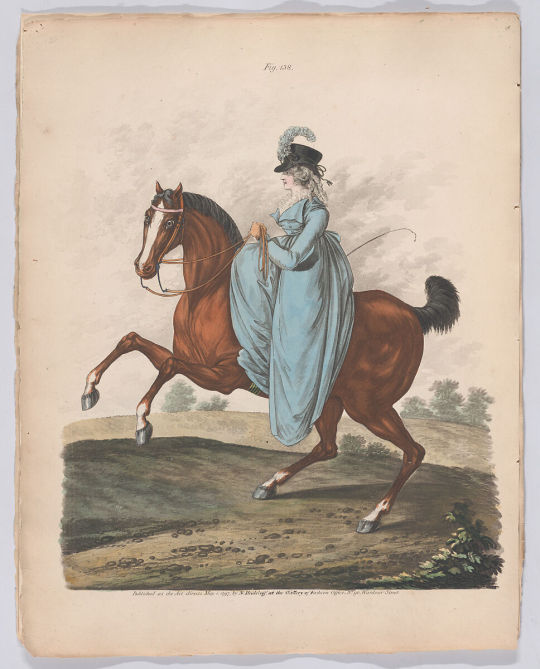
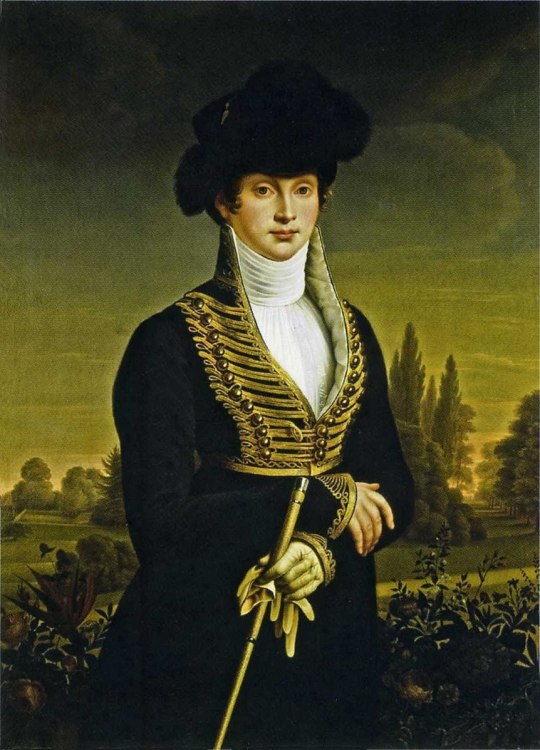
Redingote or pelisse was a long walking dress often in the masculine styles of the riding habit. It was adapted from riding habit to fashionable day wear for outdoors in 1780s. It started as very masculine in line with riding habits, but in 1800s styles without the masculine elements also appeared. Though masculine and military styles were still common. Here's first a redingote from 1800, which follows masculine fashion of the day very closely. The second is from 1810s and has collar from men's fashion and detailing and color are loose references to military styles. The third one is quite military inspired redingote from 1814. It has long train and was probably for carriage rides.
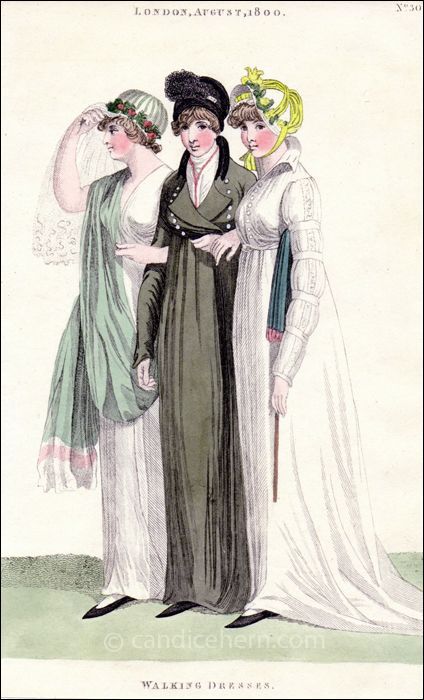


Spencer was a very short casual jacket, modelled after men's fashion again. It became fashionable in 1790s and in the following decades it gained many variations, some not at all masculine in style, and some for formal usage too. Here's very masculine styles as examples, first is from c. 1799, second from c. 1815.
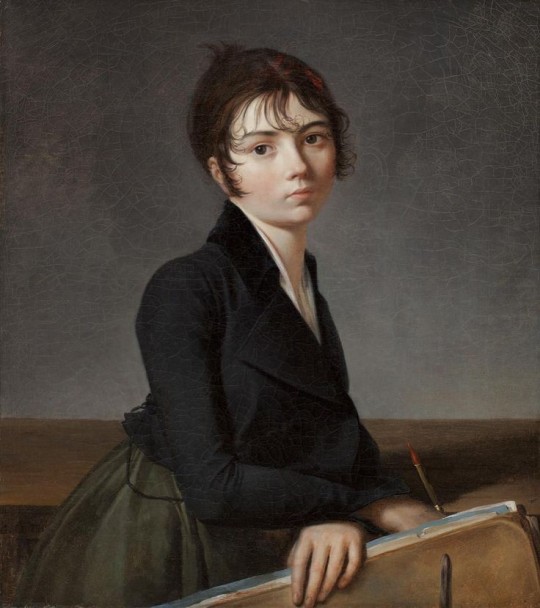

One last trend I'll mention is very short hair imitating Roman men's hairstyles, which became very fashionable for men after the French Revolution, but very similar hair for women became a trend in late 1790s. It was a bold style but for couple of decades it was very popular. I think the woman in the first example above is growing out her Titus cut. There's a little tuft on top of her head, which makes it look like her hair isn't long enough for a bun but secured at the back anyway. Here's couple of actual examples. First is from early 1800s, specific date unknown, showing a slightly longer than usual version of the style. Second is from around the same time, 1798-1805, displaying very well how hair was cut to imitate side burns, which were fashionable for men. The third example from 1809 has the typical cut, where it's very short in the back of the head and little longer and curled in the front.

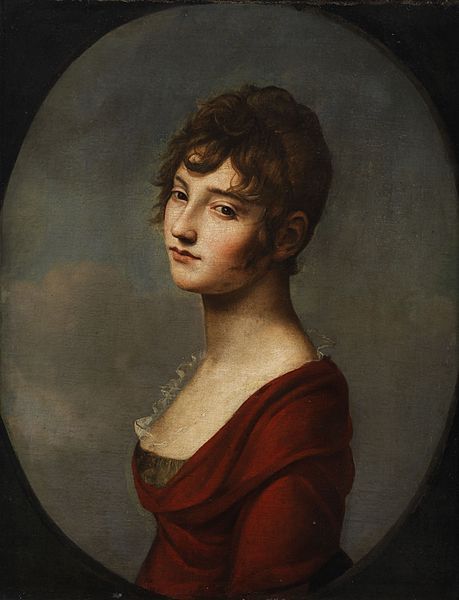
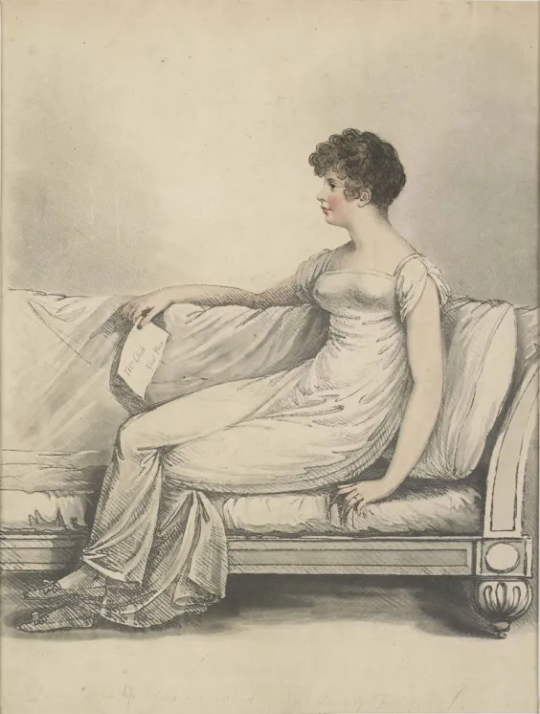
Many Regency sapphics did favour these styles, since they were acceptable ways to present in a more masculine manner. Anne Lister, perhaps the most famous Regency lesbian, presented very masculinely in her portraits. Below her outfit looks like a redingote in this 1822 painting. An infamous upper class Irish sapphic couple, Eleanor Butler and Sarah Ponsonby, lived together for decades in Whales. Here's an illustrations of them from 1818 in their older age wearing masculine redingotes and sporting Titus hairstyles.
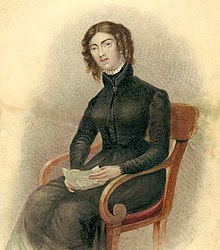
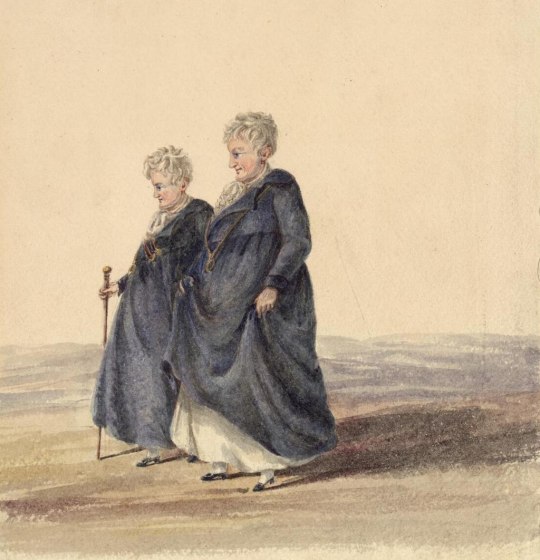
I think in a society where gnc queer people are part of the system, they might have their own slightly different dress codes. For the gnc women/afab people I'm thinking their evening dress might have redingote or spence or perhaps open robe in style of men's evening wear which was black with white cravat (second image below). The open robe could be something like the first image below but fully black, tailored, with large lapels, high collars in the white chemisette and white cravat.

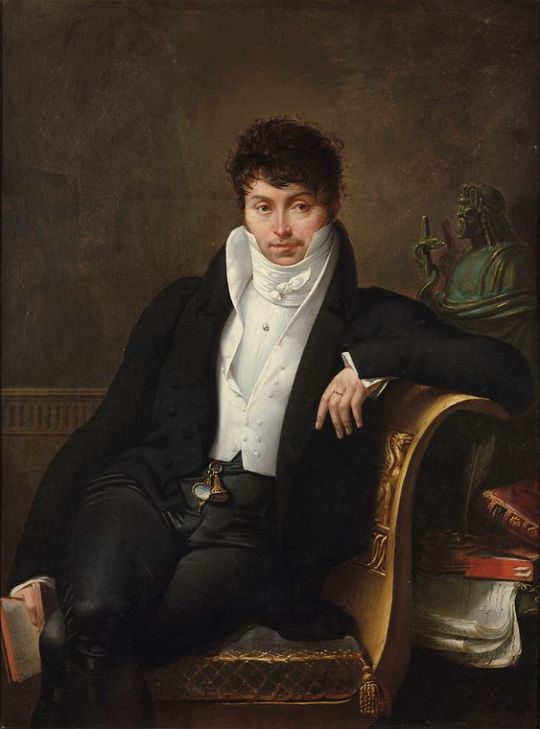
Men's gnc fashion is much harder problem since femininity in men was much less (and still very much seems to be) accepted than masculinity in women. I think it's the old patriarchal superiority of masculinity issue (even if women shouldn't break gender roles at least they are "upgrading", while men would be "downgrading"). I think it might be interesting thought to take inspiration from the styles previous to French Revolution. Regency men's fashion (all Regency fashion really) was result of the French Revolution. I talk more about it in this post, but previously manhood and womanhood had only really been fully available for the upper classes and they were based mostly on displays of wealth. The revolutionaries rejected the aristocratic gender construction and instead created their own. It was based less on class and more on the gender (and racial, but we won't have the time to touch on that here) divide. Aristocratic gender expressions were deemed decadent and the bad kind of feminine. (French Revolution may not have been the origins of the Madonna-whore complex, but they certainly cemented it to the public conscience.) That's how men's Regency fashion was stripped out of colour, detailing and luxurious materials, the overt displays of wealth. New masculine styles were all about evoking militarism, country side and practicality of a working man. Most of it was aesthetic and the class structure remained, but altered heavier in the lines of gender and race/ethnicity. To show you how the fashion was seen, here's couple of satirical cartoons both from 1787 literally calling men wearing the more courtly flamboyant styles women. (First source, second source.)
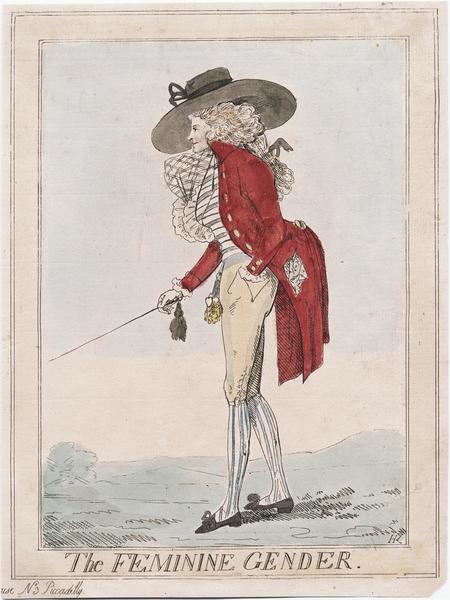

It's not entirely unrealistic that the outdated fashions would remain along the new styles. Courts were resistant to change (especially since the change had anti-monarchist implications) and upheld the outdated dress codes, so court suits were very much continuation of the fashion prior to the revolution (though court suits too started to become increasingly subdued by the 1820s). Here's examples from 1805 and 1813.
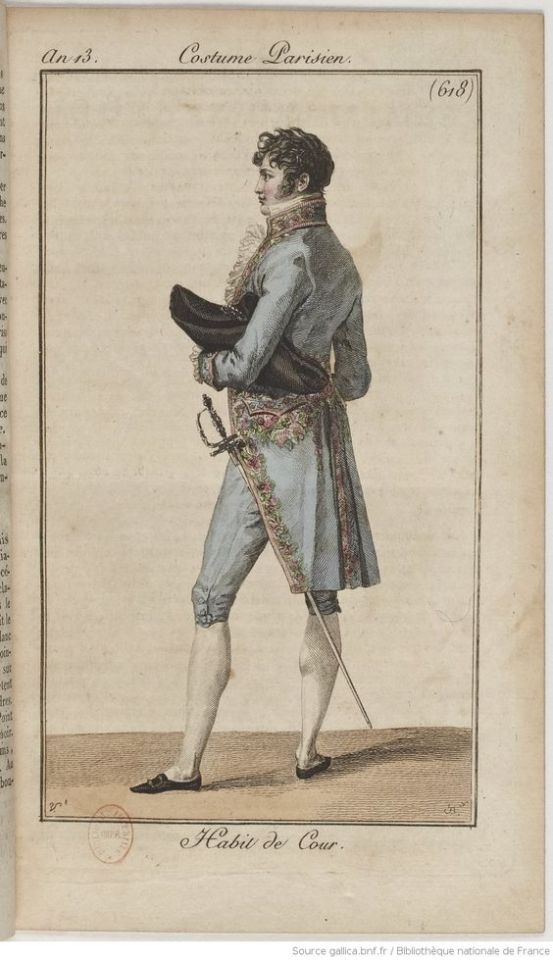
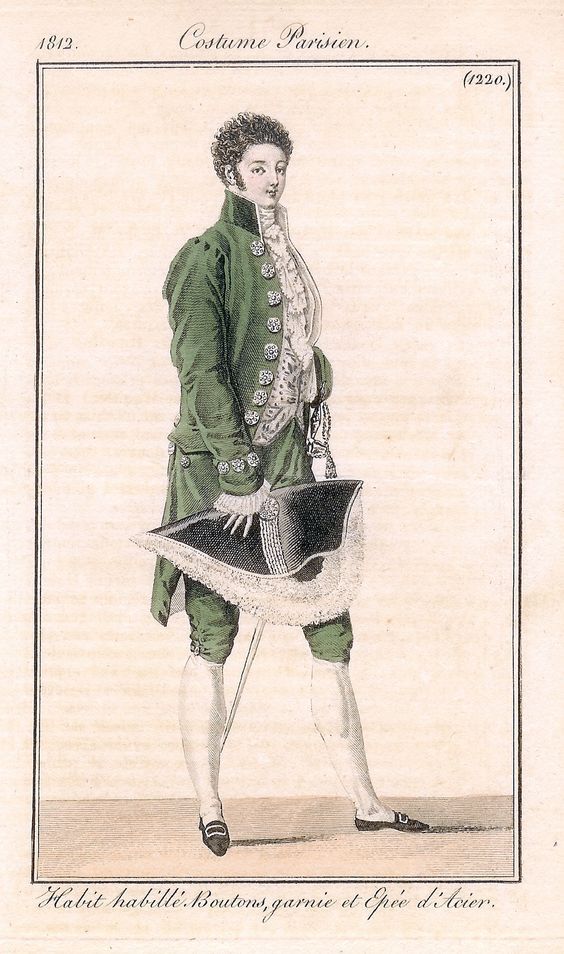
In an alternative historical world like this, I think the pre-revolution styles might have kept on and evolved as a more feminine version of the more general men's fashion. Since masculinity had been tied with rural areas and working class, I think the gnc men's style wouldn't have lapels or turned down collars, which originated from working class clothing, but upward collars like in the 18th century dress coats and Regency court suits (maybe downward collars in informal coats, but not lapels). Maybe they would keep on with the long hairstyles where they tie up their hair with a ribbon, though I don't think they would keep powdering the hair as it went out of fashion for women too. Instead they might style the front of the hair similar to women by cutting hair shorter in the front (basically a mullet) and curling the front of it to frame the face. I don't think they would be wearing the loose trousers, which were very strongly working class till the beginning of 1800s, when they started to be accepted as informal wear for upper class men. Though I think pantaloons would become informal part of feminine men's fashion after general men's fashion would start accepting them as formal wear around 1810s. Here's some examples from 1780s, which could be used as inspiration. First is from 1785-1790, second is from 1788 and the third is from c. 1770.

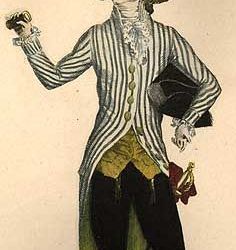
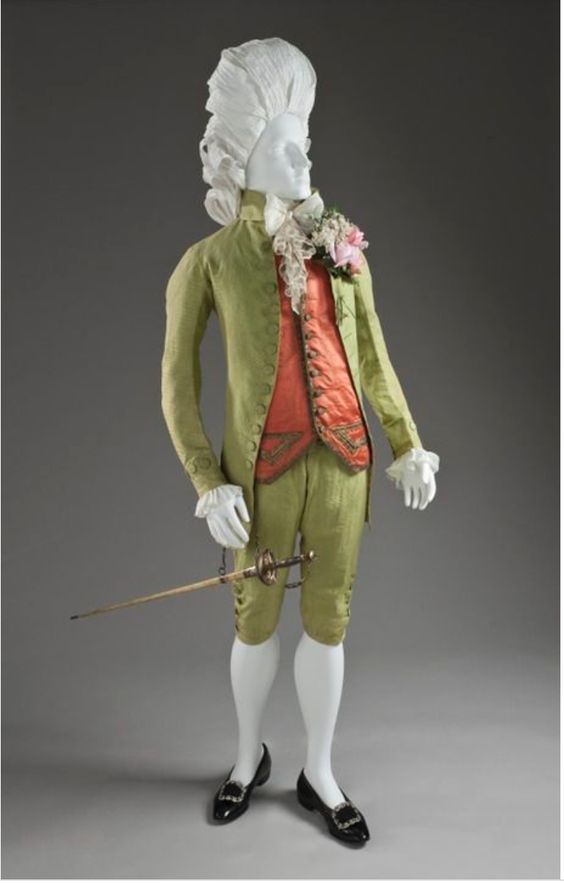
Dress coats were used still in the Regency era not just in court suits but also in morning dress. The cut and silhouette of men's fashion changed after the 1780s, most significantly with the shorter waistcoats. Here's couple of morning riding dresses (they have riding boots) from 1801 and 1806. I envision the feminine men's style as using the fashionable cuts and silhouette of the day, but combining them with the less structured and finer fabrics, patterns, colours and embelishments of pre-revolution styles. In evening wear I think they could wear white, like women, or at least light colours.

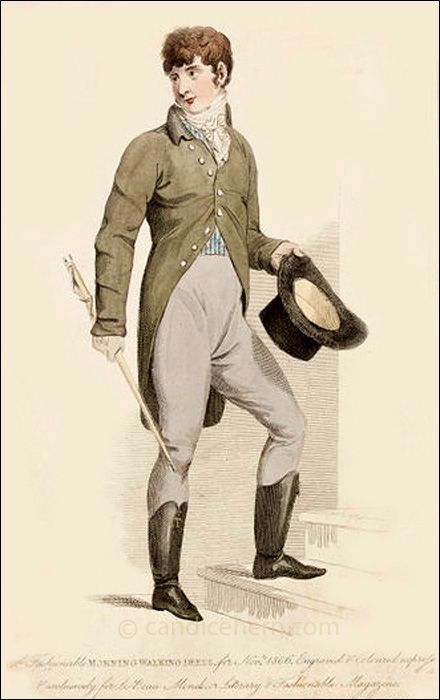
Okay, here's finally all my ideas, I had much more of them than I initially thought! It was so much fun to think about an alternative history like this, so thank you very much for your ask! I hope you found this fun or interesting to read at least, but please take my ideas as just my opinion and if any of it contradicts your vision, just ignore it. It's fiction and an alternative universe in addition so you can follow history just as much or little as you like.
Basically, your story sounds very cool, and I wish you good writing!
108 notes
·
View notes
Note
Hi! I just read your analysis of the P&P 2005 costumes. I'm currently in the process of researching Regency-period fashion for fic purposes; I'm writing a f/f story in a slightly alternate Regency world in which on top of regular marriages, parents (especially in the higher classes) could and did arrange for gay marriages for those of their children who wouldn't inherit - the principle being that the parents could set these couples up with a part of the estate that, upon those couple's death, would revert back to the estate to be inherited onwards, and thus not mess with an entailed estate all that much.
Anyway, long story short, my thought was that in these marriages, there would *still* be a masculine and feminine role, just independent of gender - and there would be according fashions. So, for example, a man's three-piece suit for a woman who took the masculine role in a f/f marriage, just cut towards the female figure, and perhaps with other nods towards the wearer's gender too, and similar for a man who took the feminine role in a m/m marriage.
I just wanted to reach out and see what you think of this and see if you'd have as much fun thinking about this as I have!
Thank you for your message, this honestly sounds really cool!! I think it's very interesting idea to come up with reasoning how arranged same sex marriage would work in a Regency class and land ownership system. I absolutely had so much fun thinking about this, maybe too much fun because look at how long this post is :'D You are entirely free to ignore all of this, I just had a lot of ideas, since your story has such an interesting premise. If you any of this catches your fancy, use it however you like!
I think it makes sense that in a very patriarchal and gender essentialist Regency society the couple would be expected to perform heterosexuality even while literally being in a gay marriage. What you described, men's clothing fitted to women's undergarments, is basically what costumes for breeches roles were usually in theater, roles for female actors, usually as a young leading boy. (Reverse roles, male actors playing female characters, usually elder/motherly roles, were just as common.) Another approach could be to use the women's silhouette, skirt with empire waist, but otherwise the clothing is similar to men's fashion. While most women's Regency styles were particularly strongly contrasted with men's styles, there was quite a lot of masculine styles too, which might work for that purpose.
I think the approach that would make most sense depends on how you want the gnc people seen and understood in the althis society of your story. In Regency society cross-dressing, women wearing pants and men wearing skirts, was seen as stepping into the other gender role. Cross-dressing was not acceptable outside theater, and people who did it needed to be stealth. So if you vision them taking the role of the opposite gender fully and not just in their relationship - living as the opposite gender and treated like that gender (for example the gnc women are allowed men's education and gnc men are not etc.) - I think it makes more sense that they would be using similar clothing as the costumes of the cross-dressing roles in theater. In that specific position it would then become acceptable to cross-dress. But if you envision them more in the societal positions of their own/assigned gender, and just embodying some opposite gender roles, especially in their marriage, I think it might make more sense for them to use the basic silhouettes of the fashion of their gender but in style the opposite gender.
So if you're interested, here's some historical styles and some additional ideas that could work as inspiration.
Before Renaissance men and women's fashions were not separate, but they started drifting apart when wearing skirts became unacceptable for men (which I have a whole long post about). However, very quickly women's fashion started to take influence from men's fashion for certain styles. Riding habit was the first one of these masculine styles for women. It originated from 17th century as men's clothing but with a skirt. From very early on men's military uniforms were a huge influence. A distinctive feature compared to other styles is the long trail so when the woman sits on the horse, her legs are not too exposed. Here's some regency examples. First example is from mid 1797-98. The bodice is exactly in the style of men's fashion of the period. Second is from 1808 in a very militaristic style.


Redingote or pelisse was a long walking dress often in the masculine styles of the riding habit. It was adapted from riding habit to fashionable day wear for outdoors in 1780s. It started as very masculine in line with riding habits, but in 1800s styles without the masculine elements also appeared. Though masculine and military styles were still common. Here's first a redingote from 1800, which follows masculine fashion of the day very closely. The second is from 1810s and has collar from men's fashion and detailing and color are loose references to military styles. The third one is quite military inspired redingote from 1814. It has long train and was probably for carriage rides.



Spencer was a very short casual jacket, modelled after men's fashion again. It became fashionable in 1790s and in the following decades it gained many variations, some not at all masculine in style, and some for formal usage too. Here's very masculine styles as examples, first is from c. 1799, second from c. 1815.


One last trend I'll mention is very short hair imitating Roman men's hairstyles, which became very fashionable for men after the French Revolution, but very similar hair for women became a trend in late 1790s. It was a bold style but for couple of decades it was very popular. I think the woman in the first example above is growing out her Titus cut. There's a little tuft on top of her head, which makes it look like her hair isn't long enough for a bun but secured at the back anyway. Here's couple of actual examples. First is from early 1800s, specific date unknown, showing a slightly longer than usual version of the style. Second is from around the same time, 1798-1805, displaying very well how hair was cut to imitate side burns, which were fashionable for men. The third example from 1809 has the typical cut, where it's very short in the back of the head and little longer and curled in the front.



Many Regency sapphics did favour these styles, since they were acceptable ways to present in a more masculine manner. Anne Lister, perhaps the most famous Regency lesbian, presented very masculinely in her portraits. Below her outfit looks like a redingote in this 1822 painting. An infamous upper class Irish sapphic couple, Eleanor Butler and Sarah Ponsonby, lived together for decades in Whales. Here's an illustrations of them from 1818 in their older age wearing masculine redingotes and sporting Titus hairstyles.


I think in a society where gnc queer people are part of the system, they might have their own slightly different dress codes. For the gnc women/afab people I'm thinking their evening dress might have redingote or spence or perhaps open robe in style of men's evening wear which was black with white cravat (second image below). The open robe could be something like the first image below but fully black, tailored, with large lapels, high collars in the white chemisette and white cravat.


Men's gnc fashion is much harder problem since femininity in men was much less (and still very much seems to be) accepted than masculinity in women. I think it's the old patriarchal superiority of masculinity issue (even if women shouldn't break gender roles at least they are "upgrading", while men would be "downgrading"). I think it might be interesting thought to take inspiration from the styles previous to French Revolution. Regency men's fashion (all Regency fashion really) was result of the French Revolution. I talk more about it in this post, but previously manhood and womanhood had only really been fully available for the upper classes and they were based mostly on displays of wealth. The revolutionaries rejected the aristocratic gender construction and instead created their own. It was based less on class and more on the gender (and racial, but we won't have the time to touch on that here) divide. Aristocratic gender expressions were deemed decadent and the bad kind of feminine. (French Revolution may not have been the origins of the Madonna-whore complex, but they certainly cemented it to the public conscience.) That's how men's Regency fashion was stripped out of colour, detailing and luxurious materials, the overt displays of wealth. New masculine styles were all about evoking militarism, country side and practicality of a working man. Most of it was aesthetic and the class structure remained, but altered heavier in the lines of gender and race/ethnicity. To show you how the fashion was seen, here's couple of satirical cartoons both from 1787 literally calling men wearing the more courtly flamboyant styles women. (First source, second source.)


It's not entirely unrealistic that the outdated fashions would remain along the new styles. Courts were resistant to change (especially since the change had anti-monarchist implications) and upheld the outdated dress codes, so court suits were very much continuation of the fashion prior to the revolution (though court suits too started to become increasingly subdued by the 1820s). Here's examples from 1805 and 1813.


In an alternative historical world like this, I think the pre-revolution styles might have kept on and evolved as a more feminine version of the more general men's fashion. Since masculinity had been tied with rural areas and working class, I think the gnc men's style wouldn't have lapels or turned down collars, which originated from working class clothing, but upward collars like in the 18th century dress coats and Regency court suits (maybe downward collars in informal coats, but not lapels). Maybe they would keep on with the long hairstyles where they tie up their hair with a ribbon, though I don't think they would keep powdering the hair as it went out of fashion for women too. Instead they might style the front of the hair similar to women by cutting hair shorter in the front (basically a mullet) and curling the front of it to frame the face. I don't think they would be wearing the loose trousers, which were very strongly working class till the beginning of 1800s, when they started to be accepted as informal wear for upper class men. Though I think pantaloons would become informal part of feminine men's fashion after general men's fashion would start accepting them as formal wear around 1810s. Here's some examples from 1780s, which could be used as inspiration. First is from 1785-1790, second is from 1788 and the third is from c. 1770.



Dress coats were used still in the Regency era not just in court suits but also in morning dress. The cut and silhouette of men's fashion changed after the 1780s, most significantly with the shorter waistcoats. Here's couple of morning riding dresses (they have riding boots) from 1801 and 1806. I envision the feminine men's style as using the fashionable cuts and silhouette of the day, but combining them with the less structured and finer fabrics, patterns, colours and embelishments of pre-revolution styles. In evening wear I think they could wear white, like women, or at least light colours.


Okay, here's finally all my ideas, I had much more of them than I initially thought! It was so much fun to think about an alternative history like this, so thank you very much for your ask! I hope you found this fun or interesting to read at least, but please take my ideas as just my opinion and if any of it contradicts your vision, just ignore it. It's fiction and an alternative universe in addition so you can follow history just as much or little as you like.
Basically, your story sounds very cool, and I wish you good writing!
108 notes
·
View notes
Note
Hi! I just read your analysis of the P&P 2005 costumes. I'm currently in the process of researching Regency-period fashion for fic purposes; I'm writing a f/f story in a slightly alternate Regency world in which on top of regular marriages, parents (especially in the higher classes) could and did arrange for gay marriages for those of their children who wouldn't inherit - the principle being that the parents could set these couples up with a part of the estate that, upon those couple's death, would revert back to the estate to be inherited onwards, and thus not mess with an entailed estate all that much.
Anyway, long story short, my thought was that in these marriages, there would *still* be a masculine and feminine role, just independent of gender - and there would be according fashions. So, for example, a man's three-piece suit for a woman who took the masculine role in a f/f marriage, just cut towards the female figure, and perhaps with other nods towards the wearer's gender too, and similar for a man who took the feminine role in a m/m marriage.
I just wanted to reach out and see what you think of this and see if you'd have as much fun thinking about this as I have!
Thank you for your message, this honestly sounds really cool!! I think it's very interesting idea to come up with reasoning how arranged same sex marriage would work in a Regency class and land ownership system. I absolutely had so much fun thinking about this, maybe too much fun because look at how long this post is :'D You are entirely free to ignore all of this, I just had a lot of ideas, since your story has such an interesting premise. If you any of this catches your fancy, use it however you like!
I think it makes sense that in a very patriarchal and gender essentialist Regency society the couple would be expected to perform heterosexuality even while literally being in a gay marriage. What you described, men's clothing fitted to women's undergarments, is basically what costumes for breeches roles were usually in theater, roles for female actors, usually as a young leading boy. (Reverse roles, male actors playing female characters, usually elder/motherly roles, were just as common.) Another approach could be to use the women's silhouette, skirt with empire waist, but otherwise the clothing is similar to men's fashion. While most women's Regency styles were particularly strongly contrasted with men's styles, there was quite a lot of masculine styles too, which might work for that purpose.
I think the approach that would make most sense depends on how you want the gnc people seen and understood in the althis society of your story. In Regency society cross-dressing, women wearing pants and men wearing skirts, was seen as stepping into the other gender role. Cross-dressing was not acceptable outside theater, and people who did it needed to be stealth. So if you vision them taking the role of the opposite gender fully and not just in their relationship - living as the opposite gender and treated like that gender (for example the gnc women are allowed men's education and gnc men are not etc.) - I think it makes more sense that they would be using similar clothing as the costumes of the cross-dressing roles in theater. In that specific position it would then become acceptable to cross-dress. But if you envision them more in the societal positions of their own/assigned gender, and just embodying some opposite gender roles, especially in their marriage, I think it might make more sense for them to use the basic silhouettes of the fashion of their gender but in style the opposite gender.
So if you're interested, here's some historical styles and some additional ideas that could work as inspiration.
Before Renaissance men and women's fashions were not separate, but they started drifting apart when wearing skirts became unacceptable for men (which I have a whole long post about). However, very quickly women's fashion started to take influence from men's fashion for certain styles. Riding habit was the first one of these masculine styles for women. It originated from 17th century as men's clothing but with a skirt. From very early on men's military uniforms were a huge influence. A distinctive feature compared to other styles is the long trail so when the woman sits on the horse, her legs are not too exposed. Here's some regency examples. First example is from mid 1797-98. The bodice is exactly in the style of men's fashion of the period. Second is from 1808 in a very militaristic style.


Redingote or pelisse was a long walking dress often in the masculine styles of the riding habit. It was adapted from riding habit to fashionable day wear for outdoors in 1780s. It started as very masculine in line with riding habits, but in 1800s styles without the masculine elements also appeared. Though masculine and military styles were still common. Here's first a redingote from 1800, which follows masculine fashion of the day very closely. The second is from 1810s and has collar from men's fashion and detailing and color are loose references to military styles. The third one is quite military inspired redingote from 1814. It has long train and was probably for carriage rides.



Spencer was a very short casual jacket, modelled after men's fashion again. It became fashionable in 1790s and in the following decades it gained many variations, some not at all masculine in style, and some for formal usage too. Here's very masculine styles as examples, first is from c. 1799, second from c. 1815.


One last trend I'll mention is very short hair imitating Roman men's hairstyles, which became very fashionable for men after the French Revolution, but very similar hair for women became a trend in late 1790s. It was a bold style but for couple of decades it was very popular. I think the woman in the first example above is growing out her Titus cut. There's a little tuft on top of her head, which makes it look like her hair isn't long enough for a bun but secured at the back anyway. Here's couple of actual examples. First is from early 1800s, specific date unknown, showing a slightly longer than usual version of the style. Second is from around the same time, 1798-1805, displaying very well how hair was cut to imitate side burns, which were fashionable for men. The third example from 1809 has the typical cut, where it's very short in the back of the head and little longer and curled in the front.



Many Regency sapphics did favour these styles, since they were acceptable ways to present in a more masculine manner. Anne Lister, perhaps the most famous Regency lesbian, presented very masculinely in her portraits. Below her outfit looks like a redingote in this 1822 painting. An infamous upper class Irish sapphic couple, Eleanor Butler and Sarah Ponsonby, lived together for decades in Whales. Here's an illustrations of them from 1818 in their older age wearing masculine redingotes and sporting Titus hairstyles.


I think in a society where gnc queer people are part of the system, they might have their own slightly different dress codes. For the gnc women/afab people I'm thinking their evening dress might have redingote or spence or perhaps open robe in style of men's evening wear which was black with white cravat (second image below). The open robe could be something like the first image below but fully black, tailored, with large lapels, high collars in the white chemisette and white cravat.


Men's gnc fashion is much harder problem since femininity in men was much less (and still very much seems to be) accepted than masculinity in women. I think it's the old patriarchal superiority of masculinity issue (even if women shouldn't break gender roles at least they are "upgrading", while men would be "downgrading"). I think it might be interesting thought to take inspiration from the styles previous to French Revolution. Regency men's fashion (all Regency fashion really) was result of the French Revolution. I talk more about it in this post, but previously manhood and womanhood had only really been fully available for the upper classes and they were based mostly on displays of wealth. The revolutionaries rejected the aristocratic gender construction and instead created their own. It was based less on class and more on the gender (and racial, but we won't have the time to touch on that here) divide. Aristocratic gender expressions were deemed decadent and the bad kind of feminine. (French Revolution may not have been the origins of the Madonna-whore complex, but they certainly cemented it to the public conscience.) That's how men's Regency fashion was stripped out of colour, detailing and luxurious materials, the overt displays of wealth. New masculine styles were all about evoking militarism, country side and practicality of a working man. Most of it was aesthetic and the class structure remained, but altered heavier in the lines of gender and race/ethnicity. To show you how the fashion was seen, here's couple of satirical cartoons both from 1787 literally calling men wearing the more courtly flamboyant styles women. (First source, second source.)


It's not entirely unrealistic that the outdated fashions would remain along the new styles. Courts were resistant to change (especially since the change had anti-monarchist implications) and upheld the outdated dress codes, so court suits were very much continuation of the fashion prior to the revolution (though court suits too started to become increasingly subdued by the 1820s). Here's examples from 1805 and 1813.


In an alternative historical world like this, I think the pre-revolution styles might have kept on and evolved as a more feminine version of the more general men's fashion. Since masculinity had been tied with rural areas and working class, I think the gnc men's style wouldn't have lapels or turned down collars, which originated from working class clothing, but upward collars like in the 18th century dress coats and Regency court suits (maybe downward collars in informal coats, but not lapels). Maybe they would keep on with the long hairstyles where they tie up their hair with a ribbon, though I don't think they would keep powdering the hair as it went out of fashion for women too. Instead they might style the front of the hair similar to women by cutting hair shorter in the front (basically a mullet) and curling the front of it to frame the face. I don't think they would be wearing the loose trousers, which were very strongly working class till the beginning of 1800s, when they started to be accepted as informal wear for upper class men. Though I think pantaloons would become informal part of feminine men's fashion after general men's fashion would start accepting them as formal wear around 1810s. Here's some examples from 1780s, which could be used as inspiration. First is from 1785-1790, second is from 1788 and the third is from c. 1770.



Dress coats were used still in the Regency era not just in court suits but also in morning dress. The cut and silhouette of men's fashion changed after the 1780s, most significantly with the shorter waistcoats. Here's couple of morning riding dresses (they have riding boots) from 1801 and 1806. I envision the feminine men's style as using the fashionable cuts and silhouette of the day, but combining them with the less structured and finer fabrics, patterns, colours and embelishments of pre-revolution styles. In evening wear I think they could wear white, like women, or at least light colours.


Okay, here's finally all my ideas, I had much more of them than I initially thought! It was so much fun to think about an alternative history like this, so thank you very much for your ask! I hope you found this fun or interesting to read at least, but please take my ideas as just my opinion and if any of it contradicts your vision, just ignore it. It's fiction and an alternative universe in addition so you can follow history just as much or little as you like.
Basically, your story sounds very cool, and I wish you good writing!
108 notes
·
View notes
Note
Hi! I just read your analysis of the P&P 2005 costumes. I'm currently in the process of researching Regency-period fashion for fic purposes; I'm writing a f/f story in a slightly alternate Regency world in which on top of regular marriages, parents (especially in the higher classes) could and did arrange for gay marriages for those of their children who wouldn't inherit - the principle being that the parents could set these couples up with a part of the estate that, upon those couple's death, would revert back to the estate to be inherited onwards, and thus not mess with an entailed estate all that much.
Anyway, long story short, my thought was that in these marriages, there would *still* be a masculine and feminine role, just independent of gender - and there would be according fashions. So, for example, a man's three-piece suit for a woman who took the masculine role in a f/f marriage, just cut towards the female figure, and perhaps with other nods towards the wearer's gender too, and similar for a man who took the feminine role in a m/m marriage.
I just wanted to reach out and see what you think of this and see if you'd have as much fun thinking about this as I have!
Thank you for your message, this honestly sounds really cool!! I think it's very interesting idea to come up with reasoning how arranged same sex marriage would work in a Regency class and land ownership system. I absolutely had so much fun thinking about this, maybe too much fun because look at how long this post is :'D You are entirely free to ignore all of this, I just had a lot of ideas, since your story has such an interesting premise. If you any of this catches your fancy, use it however you like!
I think it makes sense that in a very patriarchal and gender essentialist Regency society the couple would be expected to perform heterosexuality even while literally being in a gay marriage. What you described, men's clothing fitted to women's undergarments, is basically what costumes for breeches roles were usually in theater, roles for female actors, usually as a young leading boy. (Reverse roles, male actors playing female characters, usually elder/motherly roles, were just as common.) Another approach could be to use the women's silhouette, skirt with empire waist, but otherwise the clothing is similar to men's fashion. While most women's Regency styles were particularly strongly contrasted with men's styles, there was quite a lot of masculine styles too, which might work for that purpose.
I think the approach that would make most sense depends on how you want the gnc people seen and understood in the althis society of your story. In Regency society cross-dressing, women wearing pants and men wearing skirts, was seen as stepping into the other gender role. Cross-dressing was not acceptable outside theater, and people who did it needed to be stealth. So if you vision them taking the role of the opposite gender fully and not just in their relationship - living as the opposite gender and treated like that gender (for example the gnc women are allowed men's education and gnc men are not etc.) - I think it makes more sense that they would be using similar clothing as the costumes of the cross-dressing roles in theater. In that specific position it would then become acceptable to cross-dress. But if you envision them more in the societal positions of their own/assigned gender, and just embodying some opposite gender roles, especially in their marriage, I think it might make more sense for them to use the basic silhouettes of the fashion of their gender but in style the opposite gender.
So if you're interested, here's some historical styles and some additional ideas that could work as inspiration.
Before Renaissance men and women's fashions were not separate, but they started drifting apart when wearing skirts became unacceptable for men (which I have a whole long post about). However, very quickly women's fashion started to take influence from men's fashion for certain styles. Riding habit was the first one of these masculine styles for women. It originated from 17th century as men's clothing but with a skirt. From very early on men's military uniforms were a huge influence. A distinctive feature compared to other styles is the long trail so when the woman sits on the horse, her legs are not too exposed. Here's some regency examples. First example is from mid 1797-98. The bodice is exactly in the style of men's fashion of the period. Second is from 1808 in a very militaristic style.


Redingote or pelisse was a long walking dress often in the masculine styles of the riding habit. It was adapted from riding habit to fashionable day wear for outdoors in 1780s. It started as very masculine in line with riding habits, but in 1800s styles without the masculine elements also appeared. Though masculine and military styles were still common. Here's first a redingote from 1800, which follows masculine fashion of the day very closely. The second is from 1810s and has collar from men's fashion and detailing and color are loose references to military styles. The third one is quite military inspired redingote from 1814. It has long train and was probably for carriage rides.



Spencer was a very short casual jacket, modelled after men's fashion again. It became fashionable in 1790s and in the following decades it gained many variations, some not at all masculine in style, and some for formal usage too. Here's very masculine styles as examples, first is from c. 1799, second from c. 1815.


One last trend I'll mention is very short hair imitating Roman men's hairstyles, which became very fashionable for men after the French Revolution, but very similar hair for women became a trend in late 1790s. It was a bold style but for couple of decades it was very popular. I think the woman in the first example above is growing out her Titus cut. There's a little tuft on top of her head, which makes it look like her hair isn't long enough for a bun but secured at the back anyway. Here's couple of actual examples. First is from early 1800s, specific date unknown, showing a slightly longer than usual version of the style. Second is from around the same time, 1798-1805, displaying very well how hair was cut to imitate side burns, which were fashionable for men. The third example from 1809 has the typical cut, where it's very short in the back of the head and little longer and curled in the front.



Many Regency sapphics did favour these styles, since they were acceptable ways to present in a more masculine manner. Anne Lister, perhaps the most famous Regency lesbian, presented very masculinely in her portraits. Below her outfit looks like a redingote in this 1822 painting. An infamous upper class Irish sapphic couple, Eleanor Butler and Sarah Ponsonby, lived together for decades in Whales. Here's an illustrations of them from 1818 in their older age wearing masculine redingotes and sporting Titus hairstyles.


I think in a society where gnc queer people are part of the system, they might have their own slightly different dress codes. For the gnc women/afab people I'm thinking their evening dress might have redingote or spence or perhaps open robe in style of men's evening wear which was black with white cravat (second image below). The open robe could be something like the first image below but fully black, tailored, with large lapels, high collars in the white chemisette and white cravat.


Men's gnc fashion is much harder problem since femininity in men was much less (and still very much seems to be) accepted than masculinity in women. I think it's the old patriarchal superiority of masculinity issue (even if women shouldn't break gender roles at least they are "upgrading", while men would be "downgrading"). I think it might be interesting thought to take inspiration from the styles previous to French Revolution. Regency men's fashion (all Regency fashion really) was result of the French Revolution. I talk more about it in this post, but previously manhood and womanhood had only really been fully available for the upper classes and they were based mostly on displays of wealth. The revolutionaries rejected the aristocratic gender construction and instead created their own. It was based less on class and more on the gender (and racial, but we won't have the time to touch on that here) divide. Aristocratic gender expressions were deemed decadent and the bad kind of feminine. (French Revolution may not have been the origins of the Madonna-whore complex, but they certainly cemented it to the public conscience.) That's how men's Regency fashion was stripped out of colour, detailing and luxurious materials, the overt displays of wealth. New masculine styles were all about evoking militarism, country side and practicality of a working man. Most of it was aesthetic and the class structure remained, but altered heavier in the lines of gender and race/ethnicity. To show you how the fashion was seen, here's couple of satirical cartoons both from 1787 literally calling men wearing the more courtly flamboyant styles women. (First source, second source.)


It's not entirely unrealistic that the outdated fashions would remain along the new styles. Courts were resistant to change (especially since the change had anti-monarchist implications) and upheld the outdated dress codes, so court suits were very much continuation of the fashion prior to the revolution (though court suits too started to become increasingly subdued by the 1820s). Here's examples from 1805 and 1813.


In an alternative historical world like this, I think the pre-revolution styles might have kept on and evolved as a more feminine version of the more general men's fashion. Since masculinity had been tied with rural areas and working class, I think the gnc men's style wouldn't have lapels or turned down collars, which originated from working class clothing, but upward collars like in the 18th century dress coats and Regency court suits (maybe downward collars in informal coats, but not lapels). Maybe they would keep on with the long hairstyles where they tie up their hair with a ribbon, though I don't think they would keep powdering the hair as it went out of fashion for women too. Instead they might style the front of the hair similar to women by cutting hair shorter in the front (basically a mullet) and curling the front of it to frame the face. I don't think they would be wearing the loose trousers, which were very strongly working class till the beginning of 1800s, when they started to be accepted as informal wear for upper class men. Though I think pantaloons would become informal part of feminine men's fashion after general men's fashion would start accepting them as formal wear around 1810s. Here's some examples from 1780s, which could be used as inspiration. First is from 1785-1790, second is from 1788 and the third is from c. 1770.



Dress coats were used still in the Regency era not just in court suits but also in morning dress. The cut and silhouette of men's fashion changed after the 1780s, most significantly with the shorter waistcoats. Here's couple of morning riding dresses (they have riding boots) from 1801 and 1806. I envision the feminine men's style as using the fashionable cuts and silhouette of the day, but combining them with the less structured and finer fabrics, patterns, colours and embelishments of pre-revolution styles. In evening wear I think they could wear white, like women, or at least light colours.


Okay, here's finally all my ideas, I had much more of them than I initially thought! It was so much fun to think about an alternative history like this, so thank you very much for your ask! I hope you found this fun or interesting to read at least, but please take my ideas as just my opinion and if any of it contradicts your vision, just ignore it. It's fiction and an alternative universe in addition so you can follow history just as much or little as you like.
Basically, your story sounds very cool, and I wish you good writing!
108 notes
·
View notes
Note
Hi! I just read your analysis of the P&P 2005 costumes. I'm currently in the process of researching Regency-period fashion for fic purposes; I'm writing a f/f story in a slightly alternate Regency world in which on top of regular marriages, parents (especially in the higher classes) could and did arrange for gay marriages for those of their children who wouldn't inherit - the principle being that the parents could set these couples up with a part of the estate that, upon those couple's death, would revert back to the estate to be inherited onwards, and thus not mess with an entailed estate all that much.
Anyway, long story short, my thought was that in these marriages, there would *still* be a masculine and feminine role, just independent of gender - and there would be according fashions. So, for example, a man's three-piece suit for a woman who took the masculine role in a f/f marriage, just cut towards the female figure, and perhaps with other nods towards the wearer's gender too, and similar for a man who took the feminine role in a m/m marriage.
I just wanted to reach out and see what you think of this and see if you'd have as much fun thinking about this as I have!
Thank you for your message, this honestly sounds really cool!! I think it's very interesting idea to come up with reasoning how arranged same sex marriage would work in a Regency class and land ownership system. I absolutely had so much fun thinking about this, maybe too much fun because look at how long this post is :'D You are entirely free to ignore all of this, I just had a lot of ideas, since your story has such an interesting premise. If you any of this catches your fancy, use it however you like!
I think it makes sense that in a very patriarchal and gender essentialist Regency society the couple would be expected to perform heterosexuality even while literally being in a gay marriage. What you described, men's clothing fitted to women's undergarments, is basically what costumes for breeches roles were usually in theater, roles for female actors, usually as a young leading boy. (Reverse roles, male actors playing female characters, usually elder/motherly roles, were just as common.) Another approach could be to use the women's silhouette, skirt with empire waist, but otherwise the clothing is similar to men's fashion. While most women's Regency styles were particularly strongly contrasted with men's styles, there was quite a lot of masculine styles too, which might work for that purpose.
I think the approach that would make most sense depends on how you want the gnc people seen and understood in the althis society of your story. In Regency society cross-dressing, women wearing pants and men wearing skirts, was seen as stepping into the other gender role. Cross-dressing was not acceptable outside theater, and people who did it needed to be stealth. So if you vision them taking the role of the opposite gender fully and not just in their relationship - living as the opposite gender and treated like that gender (for example the gnc women are allowed men's education and gnc men are not etc.) - I think it makes more sense that they would be using similar clothing as the costumes of the cross-dressing roles in theater. In that specific position it would then become acceptable to cross-dress. But if you envision them more in the societal positions of their own/assigned gender, and just embodying some opposite gender roles, especially in their marriage, I think it might make more sense for them to use the basic silhouettes of the fashion of their gender but in style the opposite gender.
So if you're interested, here's some historical styles and some additional ideas that could work as inspiration.
Before Renaissance men and women's fashions were not separate, but they started drifting apart when wearing skirts became unacceptable for men (which I have a whole long post about). However, very quickly women's fashion started to take influence from men's fashion for certain styles. Riding habit was the first one of these masculine styles for women. It originated from 17th century as men's clothing but with a skirt. From very early on men's military uniforms were a huge influence. A distinctive feature compared to other styles is the long trail so when the woman sits on the horse, her legs are not too exposed. Here's some regency examples. First example is from mid 1797-98. The bodice is exactly in the style of men's fashion of the period. Second is from 1808 in a very militaristic style.


Redingote or pelisse was a long walking dress often in the masculine styles of the riding habit. It was adapted from riding habit to fashionable day wear for outdoors in 1780s. It started as very masculine in line with riding habits, but in 1800s styles without the masculine elements also appeared. Though masculine and military styles were still common. Here's first a redingote from 1800, which follows masculine fashion of the day very closely. The second is from 1810s and has collar from men's fashion and detailing and color are loose references to military styles. The third one is quite military inspired redingote from 1814. It has long train and was probably for carriage rides.



Spencer was a very short casual jacket, modelled after men's fashion again. It became fashionable in 1790s and in the following decades it gained many variations, some not at all masculine in style, and some for formal usage too. Here's very masculine styles as examples, first is from c. 1799, second from c. 1815.


One last trend I'll mention is very short hair imitating Roman men's hairstyles, which became very fashionable for men after the French Revolution, but very similar hair for women became a trend in late 1790s. It was a bold style but for couple of decades it was very popular. I think the woman in the first example above is growing out her Titus cut. There's a little tuft on top of her head, which makes it look like her hair isn't long enough for a bun but secured at the back anyway. Here's couple of actual examples. First is from early 1800s, specific date unknown, showing a slightly longer than usual version of the style. Second is from around the same time, 1798-1805, displaying very well how hair was cut to imitate side burns, which were fashionable for men. The third example from 1809 has the typical cut, where it's very short in the back of the head and little longer and curled in the front.



Many Regency sapphics did favour these styles, since they were acceptable ways to present in a more masculine manner. Anne Lister, perhaps the most famous Regency lesbian, presented very masculinely in her portraits. Below her outfit looks like a redingote in this 1822 painting. An infamous upper class Irish sapphic couple, Eleanor Butler and Sarah Ponsonby, lived together for decades in Whales. Here's an illustrations of them from 1818 in their older age wearing masculine redingotes and sporting Titus hairstyles.


I think in a society where that's part of the system, they might have their own slightly different dress codes. For the gnc women/afab people I'm thinking their evening dress might have redingote or spence or perhaps open robe in style of men's evening wear which was black with white cravat (second image below). The open robe could be something like the first image below but fully black, tailored, with large lapels, high collars in the white chemisette and white cravat.


Men's gnc fashion is much harder problem since femininity in men was much less (and still very much seems to be) accepted than masculinity in women. I think it's the old patriarchal superiority of masculinity issue (even if women shouldn't break gender roles at least they are "upgrading", while men would be "downgrading"). I think it might be interesting thought to take inspiration from the styles previous to French Revolution. Regency men's fashion (all Regency fashion really) was result of the French Revolution. I talk more about it in this post, but previously manhood and womanhood had only really been fully available for the upper classes and they were based mostly on displays of wealth. The revolutionaries rejected the aristocratic gender construction and instead created their own. It was based less on class and more on the gender (and racial, but we won't have the time to touch on that here) divide. Aristocratic gender expressions were deemed decadent and the bad kind of feminine. (French Revolution may not have been the origins of the Madonna-whore complex, but they certainly cemented it to the public conscience.) That's how men's Regency fashion was stripped out of colour, detailing and luxurious materials, the overt displays of wealth. New masculine styles were all about evoking militarism, country side and practicality of a working man. Most of it was aesthetic and the class structure remained, but altered heavier in the lines of gender and race/ethnicity. To show you how the fashion was seen, here's couple of satirical cartoons both from 1787 literally calling men wearing the more courtly flamboyant styles women. (First source, second source.)


It's not entirely unrealistic that the outdated fashions would remain along the new styles. Courts were resistant to change (especially since the change had anti-monarchist implications) and upheld the outdated dress codes, so court suits were very much continuation of the fashion prior to the revolution (though court suits too started to become increasingly subdued by the 1820s). Here's examples from 1805 and 1813.


In an alternative historical world like this, I think the pre-revolution styles might have kept on and evolved as a more feminine version of the more general men's fashion. Since masculinity had been tied with rural areas and working class, I think the gnc men's style wouldn't have lapels or turned down collars, which originated from working class clothing, but upward collars like in the 18th century dress coats and Regency court suits (maybe downward collars in informal coats, but not lapels). Maybe they would keep on with the long hairstyles where they tie up their hair with a ribbon, though I don't think they would keep powdering the hair as it went out of fashion for women too. Instead they might style the front of the hair similar to women by cutting hair shorter in the front (basically a mullet) and curling the front of it to frame the face. I don't think they would be wearing the loose trousers, which were very strongly working class till the beginning of 1800s, when they started to be accepted as informal wear for upper class men. Though I think pantaloons would become informal part of feminine men's fashion after general men's fashion would start accepting them as formal wear around 1810s. Here's some examples from 1780s, which could be used as inspiration. First is from 1785-1790, second is from 1788 and the third is from c. 1770.



Dress coats were used still in the Regency era not just in court suits but also in morning dress. The cut and silhouette of men's fashion changed after the 1780s, most significantly with the shorter waistcoats. Here's couple of morning riding dresses (they have riding boots) from 1801 and 1806. I envision the feminine men's style as using the fashionable cuts and silhouette of the day, but combining them with the less structured and finer fabrics, patterns, colours and embelishments of pre-revolution styles. In evening wear I think they could wear white, like women, or at least light colours.


Okay, here's finally all my ideas, I had much more of them than I initially thought! It was so much fun to think about an alternative history like this, so thank you very much for your ask! I hope you found this fun or interesting to read at least, but please take my ideas as just my opinion and if any of it contradicts your vision, just ignore it. It's fiction and an alternative universe in addition so you can follow history just as much or little as you like.
Basically, your story sounds very cool, and I wish you good writing!
#embarrasing!!#i forgot to link the post about how men stopped wearing skirts#it's like 'i have a whole long post about but i'm not going to tell you which post lool'#amazing#now it's there
108 notes
·
View notes
Note
Hi! I just read your analysis of the P&P 2005 costumes. I'm currently in the process of researching Regency-period fashion for fic purposes; I'm writing a f/f story in a slightly alternate Regency world in which on top of regular marriages, parents (especially in the higher classes) could and did arrange for gay marriages for those of their children who wouldn't inherit - the principle being that the parents could set these couples up with a part of the estate that, upon those couple's death, would revert back to the estate to be inherited onwards, and thus not mess with an entailed estate all that much.
Anyway, long story short, my thought was that in these marriages, there would *still* be a masculine and feminine role, just independent of gender - and there would be according fashions. So, for example, a man's three-piece suit for a woman who took the masculine role in a f/f marriage, just cut towards the female figure, and perhaps with other nods towards the wearer's gender too, and similar for a man who took the feminine role in a m/m marriage.
I just wanted to reach out and see what you think of this and see if you'd have as much fun thinking about this as I have!
Thank you for your message, this honestly sounds really cool!! I think it's very interesting idea to come up with reasoning how arranged same sex marriage would work in a Regency class and land ownership system. I absolutely had so much fun thinking about this, maybe too much fun because look at how long this post is :'D You are entirely free to ignore all of this, I just had a lot of ideas, since your story has such an interesting premise. If you any of this catches your fancy, use it however you like!
I think it makes sense that in a very patriarchal and gender essentialist Regency society the couple would be expected to perform heterosexuality even while literally being in a gay marriage. What you described, men's clothing fitted to women's undergarments, is basically what costumes for breeches roles were usually in theater, roles for female actors, usually as a young leading boy. (Reverse roles, male actors playing female characters, usually elder/motherly roles, were just as common.) Another approach could be to use the women's silhouette, skirt with empire waist, but otherwise the clothing is similar to men's fashion. While most women's Regency styles were particularly strongly contrasted with men's styles, there was quite a lot of masculine styles too, which might work for that purpose.
I think the approach that would make most sense depends on how you want the gnc people seen and understood in the althis society of your story. In Regency society cross-dressing, women wearing pants and men wearing skirts, was seen as stepping into the other gender role. Cross-dressing was not acceptable outside theater, and people who did it needed to be stealth. So if you vision them taking the role of the opposite gender fully and not just in their relationship - living as the opposite gender and treated like that gender (for example the gnc women are allowed men's education and gnc men are not etc.) - I think it makes more sense that they would be using similar clothing as the costumes of the cross-dressing roles in theater. In that specific position it would then become acceptable to cross-dress. But if you envision them more in the societal positions of their own/assigned gender, and just embodying some opposite gender roles, especially in their marriage, I think it might make more sense for them to use the basic silhouettes of the fashion of their gender but in style the opposite gender.
So if you're interested, here's some historical styles and some additional ideas that could work as inspiration.
Before Renaissance men and women's fashions were not separate, but they started drifting apart when wearing skirts became unacceptable for men (which I have a whole long post about). However, very quickly women's fashion started to take influence from men's fashion for certain styles. Riding habit was the first one of these masculine styles for women. It originated from 17th century as men's clothing but with a skirt. From very early on men's military uniforms were a huge influence. A distinctive feature compared to other styles is the long trail so when the woman sits on the horse, her legs are not too exposed. Here's some regency examples. First example is from mid 1797-98. The bodice is exactly in the style of men's fashion of the period. Second is from 1808 in a very militaristic style.


Redingote or pelisse was a long walking dress often in the masculine styles of the riding habit. It was adapted from riding habit to fashionable day wear for outdoors in 1780s. It started as very masculine in line with riding habits, but in 1800s styles without the masculine elements also appeared. Though masculine and military styles were still common. Here's first a redingote from 1800, which follows masculine fashion of the day very closely. The second is from 1810s and has collar from men's fashion and detailing and color are loose references to military styles. The third one is quite military inspired redingote from 1814. It has long train and was probably for carriage rides.



Spencer was a very short casual jacket, modelled after men's fashion again. It became fashionable in 1790s and in the following decades it gained many variations, some not at all masculine in style, and some for formal usage too. Here's very masculine styles as examples, first is from c. 1799, second from c. 1815.


One last trend I'll mention is very short hair imitating Roman men's hairstyles, which became very fashionable for men after the French Revolution, but very similar hair for women became a trend in late 1790s. It was a bold style but for couple of decades it was very popular. I think the woman in the first example above is growing out her Titus cut. There's a little tuft on top of her head, which makes it look like her hair isn't long enough for a bun but secured at the back anyway. Here's couple of actual examples. First is from early 1800s, specific date unknown, showing a slightly longer than usual version of the style. Second is from around the same time, 1798-1805, displaying very well how hair was cut to imitate side burns, which were fashionable for men. The third example from 1809 has the typical cut, where it's very short in the back of the head and little longer and curled in the front.



Many Regency sapphics did favour these styles, since they were acceptable ways to present in a more masculine manner. Anne Lister, perhaps the most famous Regency lesbian, presented very masculinely in her portraits. Below her outfit looks like a redingote in this 1822 painting. An infamous upper class Irish sapphic couple, Eleanor Butler and Sarah Ponsonby, lived together for decades in Whales. Here's an illustrations of them from 1818 in their older age wearing masculine redingotes and sporting Titus hairstyles.


I think in a society where gnc queer people are part of the system, they might have their own slightly different dress codes. For the gnc women/afab people I'm thinking their evening dress might have redingote or spence or perhaps open robe in style of men's evening wear which was black with white cravat (second image below). The open robe could be something like the first image below but fully black, tailored, with large lapels, high collars in the white chemisette and white cravat.


Men's gnc fashion is much harder problem since femininity in men was much less (and still very much seems to be) accepted than masculinity in women. I think it's the old patriarchal superiority of masculinity issue (even if women shouldn't break gender roles at least they are "upgrading", while men would be "downgrading"). I think it might be interesting thought to take inspiration from the styles previous to French Revolution. Regency men's fashion (all Regency fashion really) was result of the French Revolution. I talk more about it in this post, but previously manhood and womanhood had only really been fully available for the upper classes and they were based mostly on displays of wealth. The revolutionaries rejected the aristocratic gender construction and instead created their own. It was based less on class and more on the gender (and racial, but we won't have the time to touch on that here) divide. Aristocratic gender expressions were deemed decadent and the bad kind of feminine. (French Revolution may not have been the origins of the Madonna-whore complex, but they certainly cemented it to the public conscience.) That's how men's Regency fashion was stripped out of colour, detailing and luxurious materials, the overt displays of wealth. New masculine styles were all about evoking militarism, country side and practicality of a working man. Most of it was aesthetic and the class structure remained, but altered heavier in the lines of gender and race/ethnicity. To show you how the fashion was seen, here's couple of satirical cartoons both from 1787 literally calling men wearing the more courtly flamboyant styles women. (First source, second source.)


It's not entirely unrealistic that the outdated fashions would remain along the new styles. Courts were resistant to change (especially since the change had anti-monarchist implications) and upheld the outdated dress codes, so court suits were very much continuation of the fashion prior to the revolution (though court suits too started to become increasingly subdued by the 1820s). Here's examples from 1805 and 1813.


In an alternative historical world like this, I think the pre-revolution styles might have kept on and evolved as a more feminine version of the more general men's fashion. Since masculinity had been tied with rural areas and working class, I think the gnc men's style wouldn't have lapels or turned down collars, which originated from working class clothing, but upward collars like in the 18th century dress coats and Regency court suits (maybe downward collars in informal coats, but not lapels). Maybe they would keep on with the long hairstyles where they tie up their hair with a ribbon, though I don't think they would keep powdering the hair as it went out of fashion for women too. Instead they might style the front of the hair similar to women by cutting hair shorter in the front (basically a mullet) and curling the front of it to frame the face. I don't think they would be wearing the loose trousers, which were very strongly working class till the beginning of 1800s, when they started to be accepted as informal wear for upper class men. Though I think pantaloons would become informal part of feminine men's fashion after general men's fashion would start accepting them as formal wear around 1810s. Here's some examples from 1780s, which could be used as inspiration. First is from 1785-1790, second is from 1788 and the third is from c. 1770.



Dress coats were used still in the Regency era not just in court suits but also in morning dress. The cut and silhouette of men's fashion changed after the 1780s, most significantly with the shorter waistcoats. Here's couple of morning riding dresses (they have riding boots) from 1801 and 1806. I envision the feminine men's style as using the fashionable cuts and silhouette of the day, but combining them with the less structured and finer fabrics, patterns, colours and embelishments of pre-revolution styles. In evening wear I think they could wear white, like women, or at least light colours.


Okay, here's finally all my ideas, I had much more of them than I initially thought! It was so much fun to think about an alternative history like this, so thank you very much for your ask! I hope you found this fun or interesting to read at least, but please take my ideas as just my opinion and if any of it contradicts your vision, just ignore it. It's fiction and an alternative universe in addition so you can follow history just as much or little as you like.
Basically, your story sounds very cool, and I wish you good writing!
#historical fashion#fashion history#history#fashion#historical costuming#dress history#extant garment#costuming#regency fashion#fashion plate#painting#answers#queer history
108 notes
·
View notes
Text
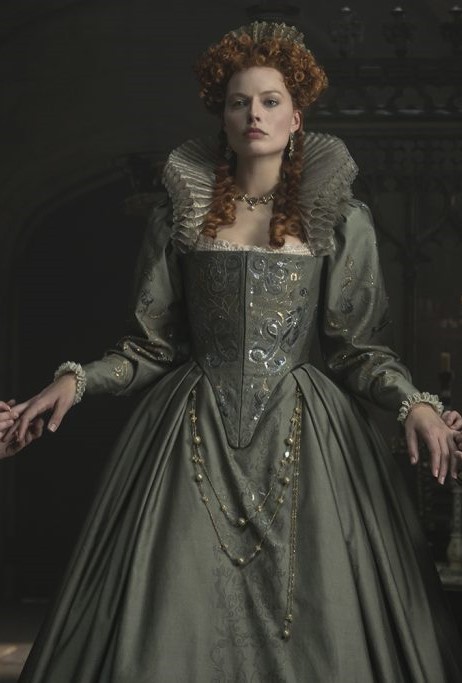

Period dramas dresses tournament: Grey/Silver dresses Round 2- Group A: Elizabeth I, Mary queen of Scots (pics set) vs Milady De Winter, The three musketeers (pics set)
Propaganda for Milady's dress
#vote for milady's campy 1630s dress!!!!#it has Sleeves curly mullet fun silhouette and period accurate tits out#if you're not convinced check the propaganda link#it's so much more fun and interesting than elizabeth's dress
46 notes
·
View notes
Text
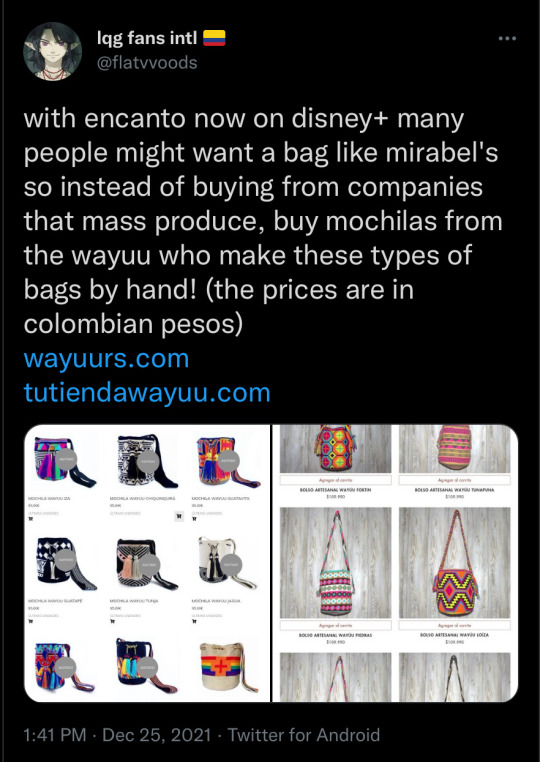
https://t.co/tQNM37KsB0
111K notes
·
View notes
Text
I’ve seen this GFM be endorsed by multiple Palestinians on Instagram - it is to help two craftspeople and their families to escape Gaza into Egypt. They had initially denied requests from people to offer money as it felt useless in the situation, but two are now looking to evacuate. Preserving traditional Palestinian crafts in the face of genocide is vital, but I’ll let the description of the fundraiser explain better than I could.
6K notes
·
View notes
Note
Borderline begging you to not erase the gender non conformity of historical women by applying contemporary lenses of gender roles to them. Gender non conforming women existed then and still exist now. Wearing “men’s clothing” does not make me less of a woman and it’s incredibly insulting to see people in 2024 call women “they” and “he” because they wrote extensively about the misogyny they faced on a daily basis and chose to address and protect against by disguising their female form. Clothing does not a gender make—social roles do. Let’s respect historical women by referring to them correctly—not assuming what they would like to be called these days when we have long since dismissed European invert theory.
I'm assuming you are referring to that historical binder post and specifically this part:
Westner was also buried in men's clothing by their own request.
Firstly, I didn't call Ella Westner "he", not sure why you are implying that. I haven't read much about Westner, but I did try to look quickly if we have any record or second hand information of them talking or writing about their gender. I didn't find it, so I don't know what would be the correct way to refer to them. I referred to them with "them" since that is the pronoun in English language when you don't know someone's gender. By all means if you have any evidence to share how they liked to be referred, do share.
This is for all intents and purposes the same ask I got after my Julie d'Aubigny post so I'm going to link my response here (and the answer to the follow up ask) instead of rehashing the same points all over again. But I will rehash couple of main points since it seems they bear repeating. Firstly, I'm not talking about you, you are not Elle Westner and you have just as little access to her mind as I do. I don't have to assume your gender, you said you're a woman, and certainly I believe nothing you do makes you less of a woman. But I can't ask Elle Westner can I? For most historical people, I think it's fair to assume their gender to be the one assigned to them, but if there is evidence that might suggest otherwise, we should not assume. Of course we should neither assume it's not their assigned gender, it's entirely possible it is, but the possibility should not be discarded that their gender is different.
It's a little silly tbh to say I'm erasing gender non-comforming historical women, when literally in the same paragraph I mention how it was quite common for queer *women* to dress in masculine clothing. This is literally what I wrote:
Queer women and trans masc people, who dressed in masculine clothing, (which was pretty common) also sometimes bound their chests, but unsurprisingly that was not exactly celebrated like drag performances were, so there weren't binders made for queer people specifically.
(I admit I didn't mention the "mannish" feminists, who dressed masculinely, but they rarely bound their chests, and like many of them were queer also.)
What I will not do (even if you borderline beg) is to erase trans masc and non-binary people from history. Assuming all historical queer and gnc people were their assigned gender without extensive evidence to the contrary (for some people no amount of evidence is ever enough) effectively erases all trans and non-binary people from history, since the way gender was talked about, understood and allowed to express, was often so different from our current understanding and usually erased from historical evidence. That is in fact imposing our understanding of gender to historical people. Yes some women did cross-dress in order to escape misogyny, but that's certainly not the only reason people cross-dressed. Especially since many of them, those who couldn't or didn't try to pass, faced even more misogyny for cross-dressing, but they did it anyway because they had other reasons to cross-dress. The reason why cross-dressing can be evidence of queer gender identity (though of course as said, there are other possible reasons) especially in 19th century, is because in their culture the understanding of gender was heavily tied to gender expression. Even today, when gender and gender expression are seem much more as separate things, if you see a person who looks like a woman, but is dressed in men's clothing, you shouldn't immediately dismiss the possibility that they might not be a woman. Yes, they might be a woman who for one reason or another likes to dress in masculine clothing, or they might not be.
You say I shouldn't "apply contemporary lenses of gender roles" to historical queer people, but also that I should in this historical context dismiss sexual inversion theory, which was specifically a Victorian lens (shrouded in scientific essentialist terms) to look at queerness. Sexual inversion theory is not biologically true of course, like it was proposed, but really none of our sexuality and gender categories are. Because while there probably is some biological explanations for our feelings of attraction and towards our bodies (which we haven't really found yet), how we built gender and sexuality categories around those feelings is entirely cultural. So while sexual inversion theory is not relevant today, it is still relevant to understand the historical context, since it was an attempt to explain scientifically their cultural construction of gender and sexuality. And of course the flaw with all these cultural categories is that they can not contain and represent the whole breath of human feelings, and will always leave people out in their explanations, which is obviously true with sexual inversion theory (but also for example our identity based model). But the societal understanding of these things also shape how we understand and frame our own feelings.
So briefly, in 19th century queer identities were emerging (not seen as just behavior anymore) and first queer communities were formed. In the texts of Victorian queer writers the understanding of sexuality, expression and gender are all very fluid. Edward Carpenter (a Victorian gay communist) notably wrote about "the intermediate sex" and "transitional men and women" which he understood as a sort of third gender category. Basically his understanding of queerness was conceptually similar to sexual inversion theory, but he came from a non-medicalizing and queer liberation angle (though like his writings were not entirely free of internalized queerphobia but still very revolutionary for his time). He wrote about this third gender category as a sort of spectrum that goes from feminine men interested in men, and masculine women interested in women, to cross-dressing people and people living as opposite gender. Today we might see these ends of the spectrum as more or less gnc gay men and women and trans men and women, which to him were more or less extreme expressions of the same phenomena. This also aligns with broader Victorian understanding of gender and sexuality, as gnc queer people were generally seen as a separate gender category, often, especially in case of queer men and trans fems, called fairies. As said, certainly not all Victorian queer people would have agreed or felt represented by these ideas, but this does give us some understanding how at least some of the queer and gnc people might have understood their gender.
Maybe I will need to make a full post about how I think gender should be handled and studied in history, so I can just link it to when I inevitably get yet another one of these.
93 notes
·
View notes
Note
Borderline begging you to not erase the gender non conformity of historical women by applying contemporary lenses of gender roles to them. Gender non conforming women existed then and still exist now. Wearing “men’s clothing” does not make me less of a woman and it’s incredibly insulting to see people in 2024 call women “they” and “he” because they wrote extensively about the misogyny they faced on a daily basis and chose to address and protect against by disguising their female form. Clothing does not a gender make—social roles do. Let’s respect historical women by referring to them correctly—not assuming what they would like to be called these days when we have long since dismissed European invert theory.
I'm assuming you are referring to that historical binder post and specifically this part:
Westner was also buried in men's clothing by their own request.
Firstly, I didn't call Ella Westner "he", not sure why you are implying that. I haven't read much about Westner, but I did try to look quickly if we have any record or second hand information of them talking or writing about their gender. I didn't find it, so I don't know what would be the correct way to refer to them. I referred to them with "them" since that is the pronoun in English language when you don't know someone's gender. By all means if you have any evidence to share how they liked to be referred, do share.
This is for all intents and purposes the same ask I got after my Julie d'Aubigny post so I'm going to link my response here (and the answer to the follow up ask) instead of rehashing the same points all over again. But I will rehash couple of main points since it seems they bear repeating. Firstly, I'm not talking about you, you are not Elle Westner and you have just as little access to her mind as I do. I don't have to assume your gender, you said you're a woman, and certainly I believe nothing you do makes you less of a woman. But I can't ask Elle Westner can I? For most historical people, I think it's fair to assume their gender to be the one assigned to them, but if there is evidence that might suggest otherwise, we should not assume. Of course we should neither assume it's not their assigned gender, it's entirely possible it is, but the possibility should not be discarded that their gender is different.
It's a little silly tbh to say I'm erasing gender non-comforming historical women, when literally in the same paragraph I mention how it was quite common for queer *women* to dress in masculine clothing. This is literally what I wrote:
Queer women and trans masc people, who dressed in masculine clothing, (which was pretty common) also sometimes bound their chests, but unsurprisingly that was not exactly celebrated like drag performances were, so there weren't binders made for queer people specifically.
(I admit I didn't mention the "mannish" feminists, who dressed masculinely, but they rarely bound their chests, and like many of them were queer also.)
What I will not do (even if you borderline beg) is to erase trans masc and non-binary people from history. Assuming all historical queer and gnc people were their assigned gender without extensive evidence to the contrary (for some people no amount of evidence is ever enough) effectively erases all trans and non-binary people from history, since the way gender was talked about, understood and allowed to express, was often so different from our current understanding and usually erased from historical evidence. That is in fact imposing our understanding of gender to historical people. Yes some women did cross-dress in order to escape misogyny, but that's certainly not the only reason people cross-dressed. Especially since many of them, those who couldn't or didn't try to pass, faced even more misogyny for cross-dressing, but they did it anyway because they had other reasons to cross-dress. The reason why cross-dressing can be evidence of queer gender identity (though of course as said, there are other possible reasons) especially in 19th century, is because in their culture the understanding of gender was heavily tied to gender expression. Even today, when gender and gender expression are seem much more as separate things, if you see a person who looks like a woman, but is dressed in men's clothing, you shouldn't immediately dismiss the possibility that they might not be a woman. Yes, they might be a woman who for one reason or another likes to dress in masculine clothing, or they might not be a woman.
You say I shouldn't "apply contemporary lenses of gender roles" to historical queer people, but also that I should in this historical context dismiss sexual inversion theory, which was specifically a Victorian lens (shrouded in scientific essentialist terms) to look at queerness. Sexual inversion theory is not biologically true of course, like it was proposed, but really none of our sexuality and gender categories are. Because while there probably is some biological explanations for our feelings of attraction and towards our bodies (which we haven't really found yet), how we built gender and sexuality categories around those feelings is entirely cultural. So while sexual inversion theory is not relevant today, it is still relevant to understand the historical context, since it was an attempt to explain scientifically their cultural construction of gender and sexuality. And of course the flaw with all these cultural categories is that they can not contain and represent the whole breath of human feelings, and will always leave people out in their explanations, which is obviously true with sexual inversion theory (but also for example our identity based model). But the societal understanding of these things also shape how we understand and frame our own feelings.
So briefly, in 19th century queer identities were emerging (not seen as just behavior anymore) and first queer communities were formed. In the texts of Victorian queer writers the understanding of sexuality, expression and gender are all very fluid. Edward Carpenter (a Victorian gay communist) notably wrote about "the intermediate sex" and "transitional men and women" which he understood as a sort of third gender category. Basically his understanding of queerness was conceptually similar to sexual inversion theory, but he came from a non-medicalizing and queer liberation angle (though like his writings were not entirely free of internalized queerphobia but still very revolutionary for his time). He wrote about this third gender category as a sort of spectrum that goes from feminine men interested in men, and masculine women interested in women, to cross-dressing people and people living as opposite gender. Today we might see these ends of the spectrum as more or less gnc gay men and women and trans men and women, which to him were more or less extreme expressions of the same phenomena. This also aligns with broader Victorian understanding of gender and sexuality, as gnc queer people were generally seen as a separate gender category, often, especially in case of queer men and trans fems, called fairies. As said, certainly not all Victorian queer people would have agreed or felt represented by these ideas, but this does give us some understanding how at least some of the queer and gnc people might have understood their gender.
Maybe I will need to make a full post about how I think gender should be handled and studied in history, so I can just link it to when I inevitably get yet another one of these.
#god damn very embarrassing to notice only now that i wrote#feminine men and feminine women#not feminine men and masculine women#dsjjg#i swear i read it before posting#my dyslexic brain is just very good at filling how i think it should read
93 notes
·
View notes
Note
Oh, I forgot to address one line there, which I have thoughts about.
Clothing does not a gender make—social roles do.
I agree with the first part, as explained in length above, but strongly disagree with the second part. Social roles are not gender. They are assigned according to gender, but if they made gender, roles like wife and mother would be required for womanhood, which is, I think, incredibly wrong. (Hot take I know.) Also according to that framing we could be pretty sure Westner wasn't a woman. They worked, never married or had children, and they dated at least one woman, all things that were explicitly contradictory to women's social role in Victorian society. Also they dressed in men's clothing. Clothing was in fact very important part of Victorian gender and other societal roles.
Like I honestly don't understand what this could actually mean. Surely not what it says since it's so contrary to everything else in the ask.
Borderline begging you to not erase the gender non conformity of historical women by applying contemporary lenses of gender roles to them. Gender non conforming women existed then and still exist now. Wearing “men’s clothing” does not make me less of a woman and it’s incredibly insulting to see people in 2024 call women “they” and “he” because they wrote extensively about the misogyny they faced on a daily basis and chose to address and protect against by disguising their female form. Clothing does not a gender make—social roles do. Let’s respect historical women by referring to them correctly—not assuming what they would like to be called these days when we have long since dismissed European invert theory.
I'm assuming you are referring to that historical binder post and specifically this part:
Westner was also buried in men's clothing by their own request.
Firstly, I didn't call Ella Westner "he", not sure why you are implying that. I haven't read much about Westner, but I did try to look quickly if we have any record or second hand information of them talking or writing about their gender. I didn't find it, so I don't know what would be the correct way to refer to them. I referred to them with "them" since that is the pronoun in English language when you don't know someone's gender. By all means if you have any evidence to share how they liked to be referred, do share.
This is for all intents and purposes the same ask I got after my Julie d'Aubigny post so I'm going to link my response here (and the answer to the follow up ask) instead of rehashing the same points all over again. But I will rehash couple of main points since it seems they bear repeating. Firstly, I'm not talking about you, you are not Elle Westner and you have just as little access to her mind as I do. I don't have to assume your gender, you said you're a woman, and certainly I believe nothing you do makes you less of a woman. But I can't ask Elle Westner can I? For most historical people, I think it's fair to assume their gender to be the one assigned to them, but if there is evidence that might suggest otherwise, we should not assume. Of course we should neither assume it's not their assigned gender, it's entirely possible it is, but the possibility should not be discarded that their gender is different.
It's a little silly tbh to say I'm erasing gender non-comforming historical women, when literally in the same paragraph I mention how it was quite common for queer *women* to dress in masculine clothing. This is literally what I wrote:
Queer women and trans masc people, who dressed in masculine clothing, (which was pretty common) also sometimes bound their chests, but unsurprisingly that was not exactly celebrated like drag performances were, so there weren't binders made for queer people specifically.
(I admit I didn't mention the "mannish" feminists, who dressed masculinely, but they rarely bound their chests, and like many of them were queer also.)
What I will not do (even if you borderline beg) is to erase trans masc and non-binary people from history. Assuming all historical queer and gnc people were their assigned gender without extensive evidence to the contrary (for some people no amount of evidence is ever enough) effectively erases all trans and non-binary people from history, since the way gender was talked about, understood and allowed to express, was often so different from our current understanding and usually erased from historical evidence. That is in fact imposing our understanding of gender to historical people. Yes some women did cross-dress in order to escape misogyny, but that's certainly not the only reason people cross-dressed. Especially since many of them, those who couldn't or didn't try to pass, faced even more misogyny for cross-dressing, but they did it anyway because they had other reasons to cross-dress. The reason why cross-dressing can be evidence of queer gender identity (though of course as said, there are other possible reasons) especially in 19th century, is because in their culture the understanding of gender was heavily tied to gender expression. Even today, when gender and gender expression are seem much more as separate things, if you see a person who looks like a woman, but is dressed in men's clothing, you shouldn't immediately dismiss the possibility that they might not be a woman. Yes, they might be a woman who for one reason or another likes to dress in masculine clothing, or they might not be a woman.
You say I shouldn't "applying contemporary lenses of gender roles" to historical queer people, but also that I should in this historical context dismiss sexual inversion theory, which was specifically a Victorian lens (shrouded in scientific essentialist terms) to look at queerness. Sexual inversion theory is not biologically true of course, like it was proposed, but really none of our sexuality and gender categories are. Because while there probably is some biological explanations for our feelings of attraction and towards our bodies (which we haven't really found yet), how we built gender and sexuality categories around those feelings is entirely cultural. So while sexual inversion theory is not relevant today, it is still relevant to understand the historical context, since it was an attempt to explain scientifically their cultural construction of gender and sexuality. And of course the flaw with all these cultural categories is that they can not contain and represent the whole breath of human feelings, and will always leave people out in their explanations, which is obviously true with sexual inversion theory (but also for example our identity based model). But the societal understanding of these things also shape how we understand and frame our own feelings.
So briefly, in 19th century queer identities were emerging (not seen as just behavior anymore) and first queer communities were formed. In the texts of Victorian queer writers the understanding of sexuality, expression and gender are all very fluid. Edward Carpenter (a Victorian gay communist) notably wrote about "the intermediate sex" and "transitional men and women" which he understood as a sort of third gender category. Basically his understanding of queerness was conceptually similar to sexual inversion theory, but he came from a non-medicalizing and queer liberation angle (though like his writings were not entirely free of internalized queerphobia but still very revolutionary for his time). He wrote about this third gender category as a sort of spectrum that goes from a bit feminine men interested in men, and a bit feminine women interested in women, to cross-dressing people and people living as opposite gender. Today we might see these ends of the spectrum as gay men and women and trans men and women, which to him were more or less extreme expressions of the same phenomena. This also aligns with broader Victorian understanding of gender and sexuality, as gnc queer people were generally seen as a separate gender category, often, especially in case of queer men and trans femmes, called fairies. As said, certainly not all Victorian queer people would have agreed or felt represented by these ideas, but this does give us some understanding how at least some of the queer and gnc people might have understood their gender.
Maybe I will need to make a full post about how I think gender should be handled and studied in history, so I can just link it to when I inevitably get yet another one of these.
93 notes
·
View notes
Note
Borderline begging you to not erase the gender non conformity of historical women by applying contemporary lenses of gender roles to them. Gender non conforming women existed then and still exist now. Wearing “men’s clothing” does not make me less of a woman and it’s incredibly insulting to see people in 2024 call women “they” and “he” because they wrote extensively about the misogyny they faced on a daily basis and chose to address and protect against by disguising their female form. Clothing does not a gender make—social roles do. Let’s respect historical women by referring to them correctly—not assuming what they would like to be called these days when we have long since dismissed European invert theory.
I'm assuming you are referring to that historical binder post and specifically this part:
Westner was also buried in men's clothing by their own request.
Firstly, I didn't call Ella Westner "he", not sure why you are implying that. I haven't read much about Westner, but I did try to look quickly if we have any record or second hand information of them talking or writing about their gender. I didn't find it, so I don't know what would be the correct way to refer to them. I referred to them with "them" since that is the pronoun in English language when you don't know someone's gender. By all means if you have any evidence to share how they liked to be referred, do share.
This is for all intents and purposes the same ask I got after my Julie d'Aubigny post so I'm going to link my response here (and the answer to the follow up ask) instead of rehashing the same points all over again. But I will rehash couple of main points since it seems they bear repeating. Firstly, I'm not talking about you, you are not Elle Westner and you have just as little access to her mind as I do. I don't have to assume your gender, you said you're a woman, and certainly I believe nothing you do makes you less of a woman. But I can't ask Elle Westner can I? For most historical people, I think it's fair to assume their gender to be the one assigned to them, but if there is evidence that might suggest otherwise, we should not assume. Of course we should neither assume it's not their assigned gender, it's entirely possible it is, but the possibility should not be discarded that their gender is different.
It's a little silly tbh to say I'm erasing gender non-comforming historical women, when literally in the same paragraph I mention how it was quite common for queer *women* to dress in masculine clothing. This is literally what I wrote:
Queer women and trans masc people, who dressed in masculine clothing, (which was pretty common) also sometimes bound their chests, but unsurprisingly that was not exactly celebrated like drag performances were, so there weren't binders made for queer people specifically.
(I admit I didn't mention the "mannish" feminists, who dressed masculinely, but they rarely bound their chests, and like many of them were queer also.)
What I will not do (even if you borderline beg) is to erase trans masc and non-binary people from history. Assuming all historical queer and gnc people were their assigned gender without extensive evidence to the contrary (for some people no amount of evidence is ever enough) effectively erases all trans and non-binary people from history, since the way gender was talked about, understood and allowed to express, was often so different from our current understanding and usually erased from historical evidence. That is in fact imposing our understanding of gender to historical people. Yes some women did cross-dress in order to escape misogyny, but that's certainly not the only reason people cross-dressed. Especially since many of them, those who couldn't or didn't try to pass, faced even more misogyny for cross-dressing, but they did it anyway because they had other reasons to cross-dress. The reason why cross-dressing can be evidence of queer gender identity (though of course as said, there are other possible reasons) especially in 19th century, is because in their culture the understanding of gender was heavily tied to gender expression. Even today, when gender and gender expression are seem much more as separate things, if you see a person who looks like a woman, but is dressed in men's clothing, you shouldn't immediately dismiss the possibility that they might not be a woman. Yes, they might be a woman who for one reason or another likes to dress in masculine clothing, or they might not be.
You say I shouldn't "apply contemporary lenses of gender roles" to historical queer people, but also that I should in this historical context dismiss sexual inversion theory, which was specifically a Victorian lens (shrouded in scientific essentialist terms) to look at queerness. Sexual inversion theory is not biologically true of course, like it was proposed, but really none of our sexuality and gender categories are. Because while there probably is some biological explanations for our feelings of attraction and towards our bodies (which we haven't really found yet), how we built gender and sexuality categories around those feelings is entirely cultural. So while sexual inversion theory is not relevant today, it is still relevant to understand the historical context, since it was an attempt to explain scientifically their cultural construction of gender and sexuality. And of course the flaw with all these cultural categories is that they can not contain and represent the whole breath of human feelings, and will always leave people out in their explanations, which is obviously true with sexual inversion theory (but also for example our identity based model). But the societal understanding of these things also shape how we understand and frame our own feelings.
So briefly, in 19th century queer identities were emerging (not seen as just behavior anymore) and first queer communities were formed. In the texts of Victorian queer writers the understanding of sexuality, expression and gender are all very fluid. Edward Carpenter (a Victorian gay communist) notably wrote about "the intermediate sex" and "transitional men and women" which he understood as a sort of third gender category. Basically his understanding of queerness was conceptually similar to sexual inversion theory, but he came from a non-medicalizing and queer liberation angle (though like his writings were not entirely free of internalized queerphobia but still very revolutionary for his time). He wrote about this third gender category as a sort of spectrum that goes from feminine men interested in men, and masculine women interested in women, to cross-dressing people and people living as opposite gender. Today we might see these ends of the spectrum as more or less gnc gay men and women and trans men and women, which to him were more or less extreme expressions of the same phenomena. This also aligns with broader Victorian understanding of gender and sexuality, as gnc queer people were generally seen as a separate gender category, often, especially in case of queer men and trans fems, called fairies. As said, certainly not all Victorian queer people would have agreed or felt represented by these ideas, but this does give us some understanding how at least some of the queer and gnc people might have understood their gender.
Maybe I will need to make a full post about how I think gender should be handled and studied in history, so I can just link it to when I inevitably get yet another one of these.
#i did end up writing more than i intended#and rehashing most of the same points as in the previous answer :')#queer history#history#victorian era#anon#answers
93 notes
·
View notes
Note
Hi, while looking through extant garments in a museum collection for reference for a school project, I found several garments of different designs that were all labelled as "binder" without any other context or explanation. Obviously my first thought was the kind of binder I use, especially for the first one that looks elasticated, but I have to assume they're for something else like gynecomastia or compression..? Do you know happen to know anything about them?
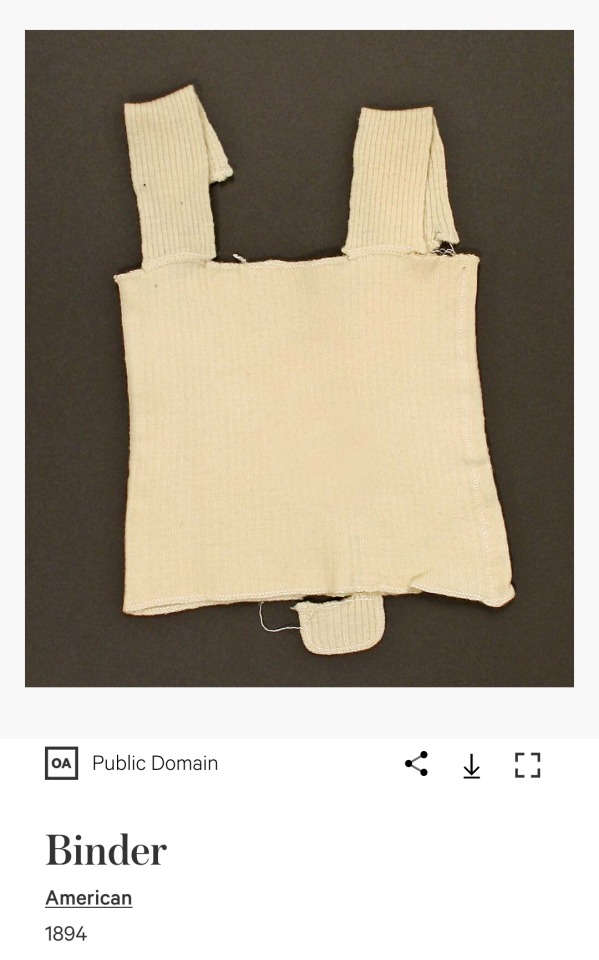
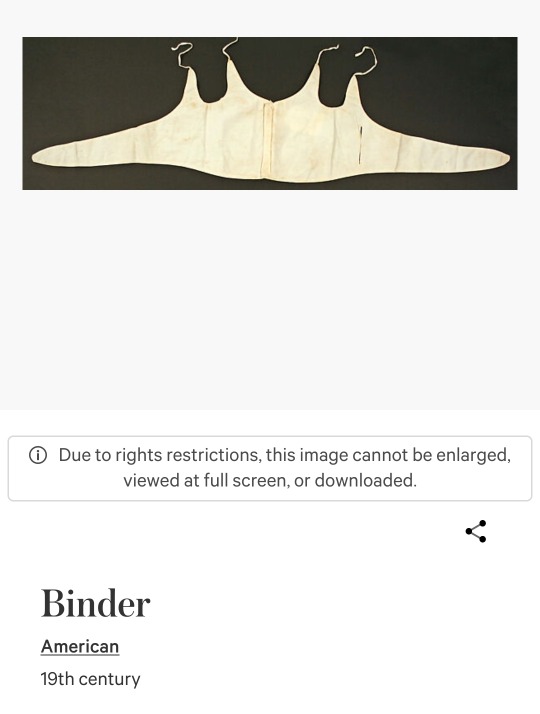
This is interesting!
They could actually be the types of binders you use. I immediately thought of 19th century male impersonators - female (?) actors who specialized in male roles in Vaudeville and other similar forms of theater, in which drag was integral part of, and would also have their own one man impersonation comedy and music shows and male stage personas. Basically they were drag kings. (Similarly female impersonators, basically drag queens, were also quite popular.) They were known to bind their chest, and other actors, who didn't necessarily do the impersonation shows, but played male roles on stage, would also often bind their chest for their performance. Here's for example two successful male impersonators, British Vesta Tilley (first picture) and American Ella Westner (second picture).
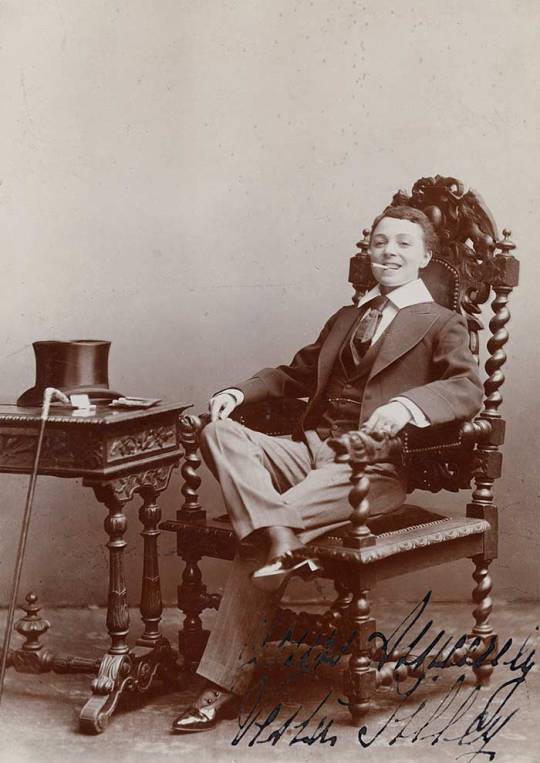
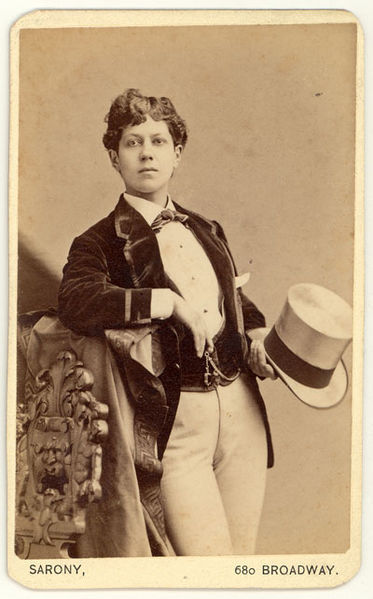

Queer women and trans masc people, who dressed in masculine clothing, (which was pretty common) also sometimes bound their chests, but unsurprisingly that was not exactly celebrated like drag performances were, so there weren't binders made for queer people specifically. I'm guessing they either made their own binders or used binders made for actors. Often those actors were the same people as those queer people, since drag performance was one of the few socially acceptable ways to fuck around with gender. Not all of them were queer, Vesta Tilley looks excellently queer in her drag, but outside stage she was respectable member of high society and very supportive of her husband who became conservative member of parliament (after she had retired). And I think we can easily imagine what kind of political opinions about queer people she was supporting when he was conservative in the context of 1923 Britain. But many of them were known to be queer, like Ella Westner, who eloped to Paris with a very interesting woman, Josie Mansfield (pictured in the last photo above), who was mistress to an infamous scammer and the man who murdered him. Westner was also buried in men's clothing by their own request.
I couldn't find pictures though what did the binders used for chest binding looked like, so I decided to look into what kind of other binders were used in the era. I think the first binder or perhaps both of them could be baby/infant binders (first two pictures below). Apparently people in Victorian era (and in 18th century) believed that chilled abdomen could cause cholera and I guess other bowel issues, so they treated cholera and tried to prevent it by wearing binders and belts (last picture), which could be also made from flannel or wool knit for extra warmth. And babies are quite vulnerable to bowel issues and cholera, so they made binders for babies too. I've seen many different types for these (for both baby and adult use) with some of them like cloth wraps, and some of them kinda corset looking though not corset shaped. If the binders you found were indeed for abdomen warming purposes, I'm sure they are for babies, since those for adults would be so low there definitely wouldn't be shoulder straps like that. The proportions on the first binder especially seem to me fitting for a baby, like the straps feel a bit too wide for adult scale. The second one is harder to guess, it could be a baby binder, but it seems to have boning in the middle, which would make maybe more sense in a chest binder?
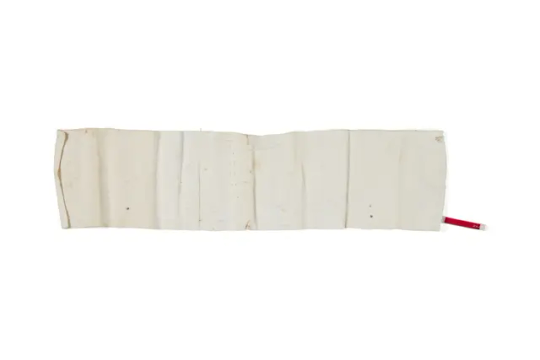


But yeah Victorian medicine continues to be... interesting.
84 notes
·
View notes
Note
I haven't read the book, I was just responding to what the comment said, not really to the book itself, so my judgement that the book is probably influenced by when it was written than where it's set could be totally wrong. But I will say that 40+ years is a pretty long time and human memory is infallible and living decades in a changing society does change us. For example if I would want to learn from movies about the culture of 70s, I would rather watch a 70s movie that 2020s movie set in 70s even if it was written and directed by people born in 60s.
But I do admit that I could be wrong and it could be totally accurate book to it's setting, it's just that I maybe wouldn't use fiction written decades later as like historical evidence. Also I don't know how that part was presented in the book so I was just responding to the interpretation of the first comment.
the gilded age costuming is interesting in that they deliberately take inspiration from later designs for bertha and gladys to emphasise the “nouveau riche” while the old money characters will be clothed in more historically accurate fashions (some are even direct replicas of paintings/extant garments)
I do understand the urge to do that, and I know it's approach with a lot of historical costuming, but personally I dislike that approach. I think it misunderstands the point of fashion in Victorian society. Today we think of the most fashionable people to be very forward thinking in their fashion and for formal clothing to be most fashionable. Red carpet is often treated as fashion event. However, this was not the case in Victorian society. Fashion was social decorum, it was a requirement to participate in high society. Or rather it was requirement to participate in society at all. Even workers adhered to the fashionable silhouette, while working. Here's for example factory workers from mid 1890s with perfectly fashionable silhouettes with the big sleeves and all.
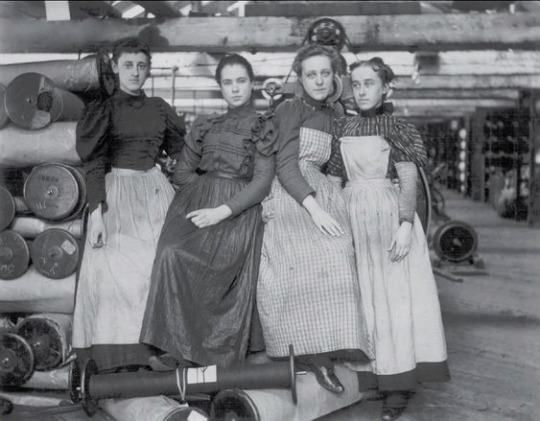
I think it's quite backwards to think nouveau rich would be experimenting with futuristic fashion. It's unthinkable they wouldn't adhere to the fashionable silhouette for high society events especially. They were the ones trying to establish themselves as part of high society, so they would be the ones most religiously following the fashionable silhouettes and styles. This is why tea gowns were much more experimental, and why the counter cultural Aesthetic style, which rejected the Victorian silhouette, could first entered high society through tea gowns. Tea gowns were worn in more intimate society gatherings (afternoon tea with neighbors and friends), so there was more room to experiment with new counter cultural styles. Tea gowns in 1880s had many of the elements that would become fashionable in 1890s, looser fit in bodice, natural form bustle and even balloon sleeves. Some British middle class/upper middle class women would dress in Aesthetic dress during 1880s in public society events, but they were not part of the upper echelon of high societies and no one dressed that way in high society evening events. The old money rich people also had more room to experiment with more unconventional fashion than nouveau rich, since their position in the exclusive high society was so much more secure, even if they were not as respectable (and adhering to the fashion ideals was about respectability) as expected of high society, their connections and status protected them from consequences. Money was not enough to secure your status, you needed connections.
#the interpretation given in that comment just fitted really well to what i know about 1920s fashion#so i thought the time it was written might explain that#but yeah i can't actually like talk about the content of the book
107 notes
·
View notes
Note
Hi, while looking through extant garments in a museum collection for reference for a school project, I found several garments of different designs that were all labelled as "binder" without any other context or explanation. Obviously my first thought was the kind of binder I use, especially for the first one that looks elasticated, but I have to assume they're for something else like gynecomastia or compression..? Do you know happen to know anything about them?


This is interesting!
They could actually be the types of binders you use. I immediately thought of 19th century male impersonators - female (?) actors who specialized in male roles in Vaudeville and other similar forms of theater, in which drag was integral part of, and would also have their own one man impersonation comedy and music shows and male stage personas. Basically they were drag kings. (Similarly female impersonators, basically drag queens, were also quite popular.) They were known to bind their chest, and other actors, who didn't necessarily do the impersonation shows, but played male roles on stage, would also often bind their chest for their performance. Here's for example two successful male impersonators, British Vesta Tilley (first picture) and American Ella Westner (second picture).



Queer women and trans masc people, who dressed in masculine clothing, (which was pretty common) also sometimes bound their chests, but unsurprisingly that was not exactly celebrated like drag performances were, so there weren't binders made for queer people specifically. I'm guessing they either made their own binders or used binders made for actors. Often those actors were the same people as those queer people, since drag performance was one of the few socially acceptable ways to fuck around with gender. Not all of them were queer, Vesta Tilley looks excellently queer in her drag, but outside stage she was respectable member of high society and very supportive of her husband who became conservative member of parliament (after she had retired). And I think we can easily imagine what kind of political opinions about queer people she was supporting when he was conservative in the context of 1923 Britain. But many of them were known to be queer, like Ella Westner, who eloped to Paris with a very interesting woman, Josie Mansfield (pictured in the last photo above), who was mistress to an infamous scammer and the man who murdered him. Westner was also buried in men's clothing by their own request.
I couldn't find pictures though what did the binders used for chest binding looked like, so I decided to look into what kind of other binders were used in the era. I think the first binder or perhaps both of them could be baby/infant binders (first two pictures below). Apparently people in Victorian era (and in 18th century) believed that chilled abdomen could cause cholera and I guess other bowel issues, so they treated cholera and tried to prevent it by wearing binders and belts (last picture), which could be also made from flannel or wool knit for extra warmth. And babies are quite vulnerable to bowel issues and cholera, so they made binders for babies too. I've seen many different types for these (for both baby and adult use) with some of them like cloth wraps, and some of them kinda corset looking though not corset shaped. If the binders you found were indeed for abdomen warming purposes, I'm sure they are for babies, since those for adults would be so low there definitely wouldn't be shoulder straps like that. The proportions on the first binder especially seem to me fitting for a baby, like the straps feel a bit too wide for adult scale. The second one is harder to guess, it could be a baby binder, but it seems to have boning in the middle, which would make maybe more sense in a chest binder?



But yeah Victorian medicine continues to be... interesting.
#extant garment#historical fashion#fashion history#history#victorian fashion#queer history#undergarments#historical clothing#dress history#historical binder#photography#answers
84 notes
·
View notes